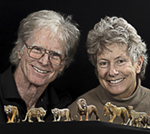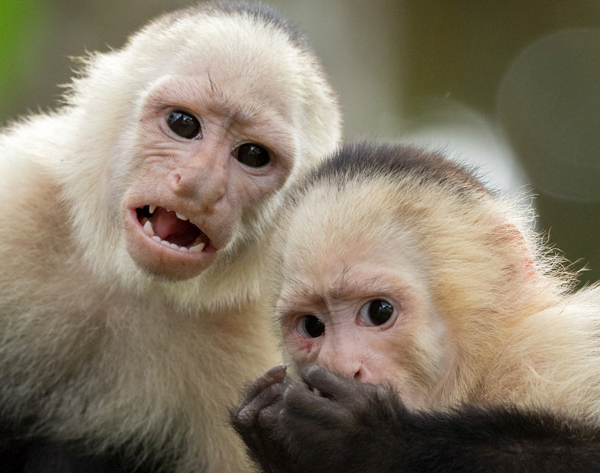
White-faced Capuchin Monkeys
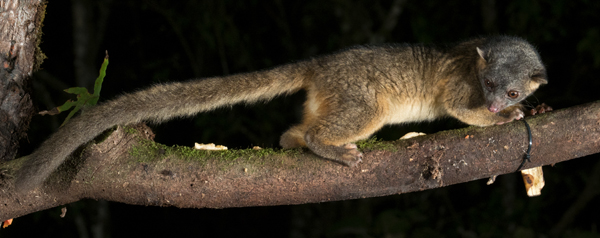
Olingo
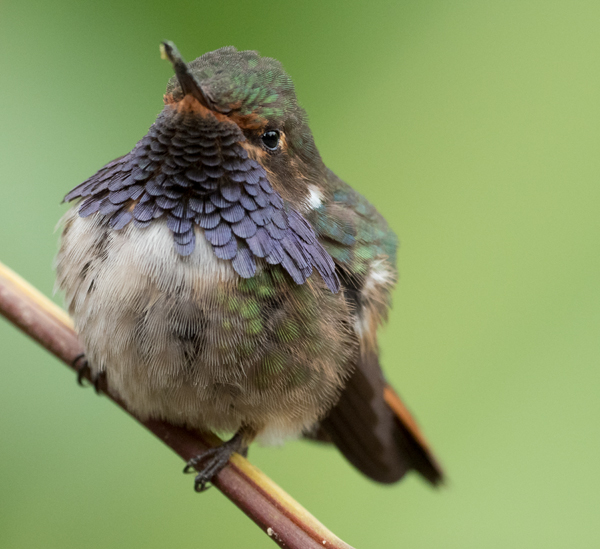
Volcano Hummingbird
Costa Rica 2019
Hummingbirds, Birds, and Wildlife Photo Tour
TRIP REPORT
Our January trip was, hands down, the best ever. We had a great group that generated incredible karma – a point our in-country guide commented upon, and our luck was fantastic. Although Mary and I brought two Canon cameras, thinking we’d need them for our Bat photography, we never used any of that gear. Instead, we used our Olympus equipment for all of our shooting, and I think we were a bit envied at times, as our close-focusing abilities, hand-holding 800mm, ProCapture, and the light weight of the gear really shined on this trip.
We visited a few new areas, and had incredible luck with our usual locations. For me, my nemesis has always been Sloths, as our groups have had great luck, while I’ve always been in the wrong place at the right time whenever the group had one. Not this year! Our guide located us in the forest when he found a Three-toed Sloth close to the Park entrance, and while we were filming it, we had another. More on that later.
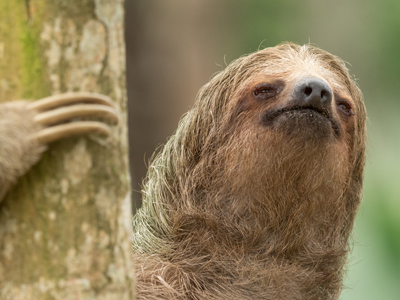 For some, and for us surely, one of the highlights was our saving a Three-toed Sloth that was crossing a road around a pineapple plantation. Our guide carried it by its back fur and placed it on a small tree by a fence, but as we assessed the situation I realized that the Sloth would be in serious trouble – any forest was far off, and the sloth would have had to travel through prickly pineapples to get there. So I carried the sloth towards the distant forest, until it got its foreleg positioned to reach back and scrape me with its sharp claws. Luckily, it didn’t break the skin, and after that, I left my more experienced guide to carry the sloth the rest of the way. When we placed it on a tree, the Sloth just calmly looked about, seemingly smiling and thanking us, and appeared to be in no hurry to climb higher. Can you imagine – this alien space travel for the Sloth!
For some, and for us surely, one of the highlights was our saving a Three-toed Sloth that was crossing a road around a pineapple plantation. Our guide carried it by its back fur and placed it on a small tree by a fence, but as we assessed the situation I realized that the Sloth would be in serious trouble – any forest was far off, and the sloth would have had to travel through prickly pineapples to get there. So I carried the sloth towards the distant forest, until it got its foreleg positioned to reach back and scrape me with its sharp claws. Luckily, it didn’t break the skin, and after that, I left my more experienced guide to carry the sloth the rest of the way. When we placed it on a tree, the Sloth just calmly looked about, seemingly smiling and thanking us, and appeared to be in no hurry to climb higher. Can you imagine – this alien space travel for the Sloth!
Here’s the report.
Day 1. Everyone arrived safely, either today or on the preceding day -- which we recommend because of the potential of delays with winter weather. Most photographers spent some time in the gardens at the hotel, and that evening we had our group welcome dinner and an orientation program on the trip.
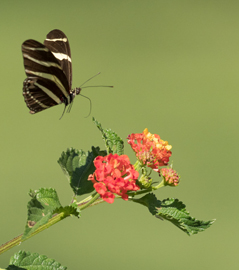
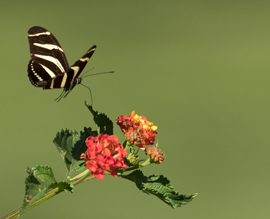
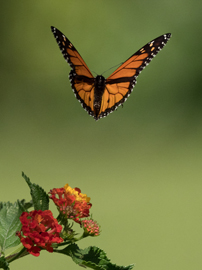
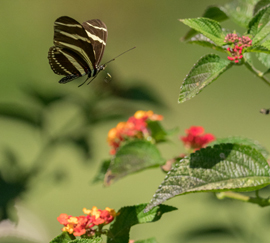
Free-flying butterflies captured with ProCapture
I spent a portion of the afternoon using ProCapture with my Olympus OMD-E Mark II camera on butterflies. ProCapture records images in a continuous loop when the camera shutter is half-pressed, and, when the shutter is fully depressed, ie the camera fires, the preceeding 14 images are recorded as well. In this way, as butterflies either flew in to a flower, or lifted off, I fired, and each time, of course, my own reaction time was too late. But with ProCapture, I caught butterflies as they were still in flight. Catching focus was another matter -- I had to be lucky for a butterfly to be in the plane of focus, but I did so several times. When I showed images to the group that evening, everyone was stunned ... and very impressed!
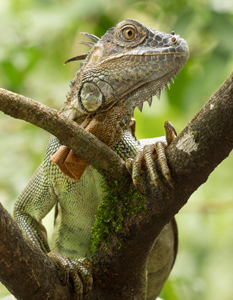 Day 2. This morning we headed north towards Arenal Volcano, the site of our first shoot. Traffic congestion was bad, so we took an alternate route that allowed us to visit a good restaurant where Tree Iguanas are easily photographed from the road and the restaurant’s porch. After lunch, we headed on to Arenal, with an extremely productive stop at a small wildlife sanctuary where we had our first Sloths.
Day 2. This morning we headed north towards Arenal Volcano, the site of our first shoot. Traffic congestion was bad, so we took an alternate route that allowed us to visit a good restaurant where Tree Iguanas are easily photographed from the road and the restaurant’s porch. After lunch, we headed on to Arenal, with an extremely productive stop at a small wildlife sanctuary where we had our first Sloths.
The group was centered at a pond, where we were photographing Spectacled Caiman and Boat-billed Herons, and a great Broad-billed Mot-mot, when our guide found us and directed us to a Sloth, clearly visible in a tree. Over the next hour or so the Sloth moved to two more trees, giving us several shooting opportunities, and while we were shooting it, we discovered a younger Sloth was buried in the vegetation along the trail. That one eventually climbed a vine right over our trail, just feet away, as it descended to do its weekly defecation, which, oddly enough, Sloths always do on the ground. Some leaves gave the Sloth some privacy, and I couldn’t tell if the Sloth dug a hole or not.
We arrived at Arenal at dusk.
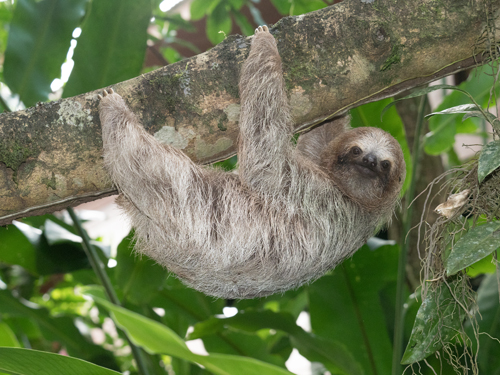
Day 3. Today we headed to a private Reptile Zoo for a very productive shoot. The staff had collected a variety of props, and we were able to shoot the snakes, lizards, frogs, and more in very natural-looking habitats. I set up a multi-flash system for several subjects, including the world’s largest species of Pit-Viper, the Bushmaster, as well as Fer-de-Lance, Jumping Vipers, and other snakes. One of the highlights was, of course, the Red-eyed Treefrog, but another was the Bush Viper I set up for a great landscape shot. We shot there all day.
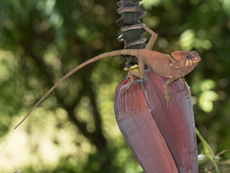
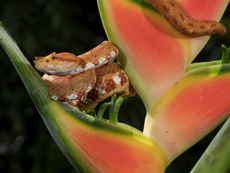
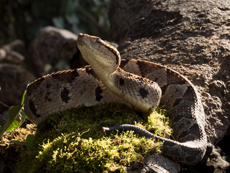
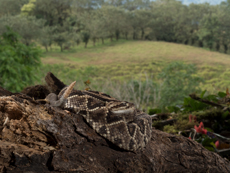
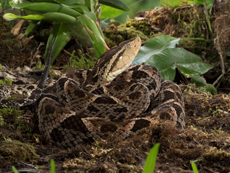
Helmeted Iguana; Eyelash Viper
Jumping Viper; Neotropical Rattlesnake
Fer-de-Lance
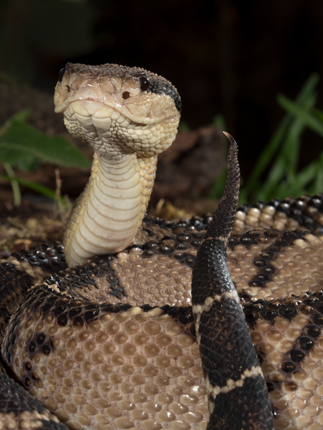
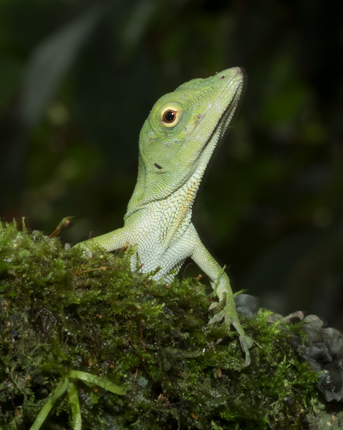
Bushmaster; Tree Anole
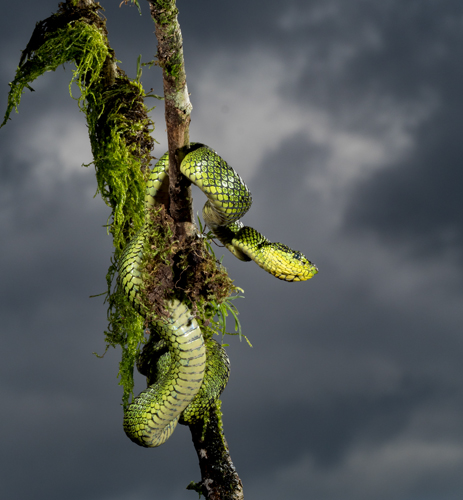
Arboreal Viper
Day 4. After breakfast we headed to our next location, our favorite lodge in northern Costa Rica not far from the Nicaraguan border. There is a special blind there where King Vultures often arrive at a bait, and photographers earlier in the day had baited and used the blind. Fortunately, in the afternoon it was open, and several of us went in, and had five King Vultures, for some great shooting. The others in the group shot from the porch, where a variety of birds continually visited the feeders.
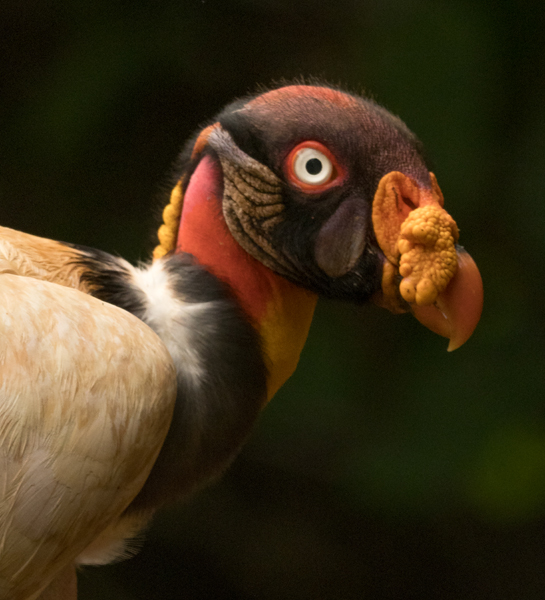
Day 5. We did two shifts to a local home where we had two flash setups for Hummingbirds. One group went in the morning, alternating their time between the hummingbirds and natural light (with fill flash) shooting of a variety of songbirds visiting a wonderful bait station. The others in the group shot the birds at the lodge, and, in the afternoon, the two groups switched.
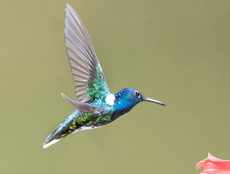
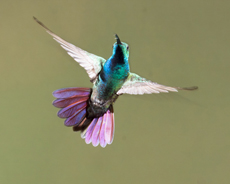
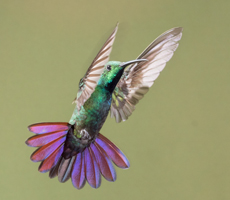
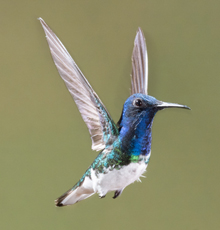
White-necked Jacobin and Green-breasted Mango
I did the morning hummingbird shift, giving me the free-time needed to set up for our Bat photography that evening. At 5, our group setup for the bats, and by the time we were finished night had fallen and the bats were flying. We kept our cameras going while we had dinner, and returned for more shooting afterwards, concluding after about 1,000 shots of bats. I used a Range IR to trip the four Phottix Manual flashes I used, and with our Olympus gear, using the Time-Lapse movie feature to advance the frame, Mary and I were able to advance frames without using an electronic release. That proved very successful!
I’m doing a how-to video on our Bat Photography here, which will be available shortly – either here, or from our home page.
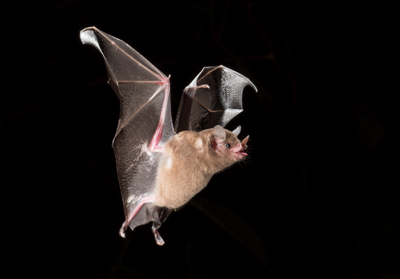
Orange-necter feeding Bat
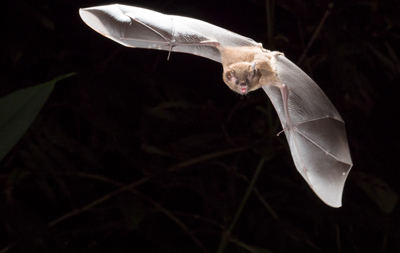
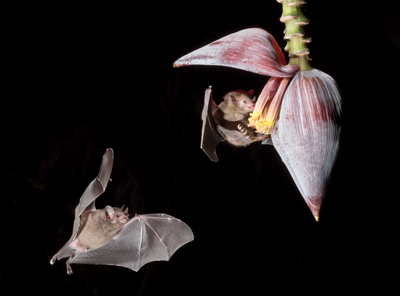
Pallas Long-tongued Bat
Day 5. The AM photographers did the afternoon hummingbird shift, while the PM did the morning. Both shoots went very well. When not shooting at the off-site location, the photographers worked on the Toucans, Tanagers, Woodpeckers, and more that visited the bird feeders at the lodge.
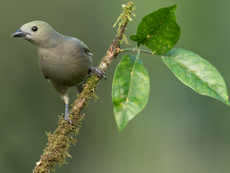
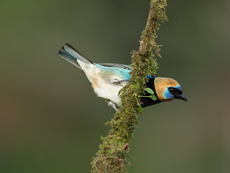
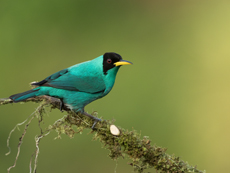
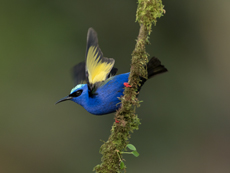
Palm Tanager; Golden-hooded Tanager
Green Honeycreeper; Red-legged Honeycreeper
Yesterday, two of our participants did the optional canoe cruise, and successfully found an Agami Heron, the most beautiful of the Western Hemisphere Herons. This afternoon, another participant did the same cruise, but unfortunately was facing the boatman, not the front of the canoe, when they launched. He asked if he could move and reverse himself, but in doing so he sat on the gunnel and the canoe capsized, spilling him and his gear (one camera and lens, only, luckily) and the boatman, who dunked his cellphone, too. Only later did we learn that he had never been in a canoe before, and was understandably unfamiliar with how unstable a canoe can be.
I launched just minutes later, in a different canoe, and proceeded without disaster. I didn’t see the Agami, but did manage nice shots of a Muscovy Duck and of a Neotropical Otter, a very rare find. 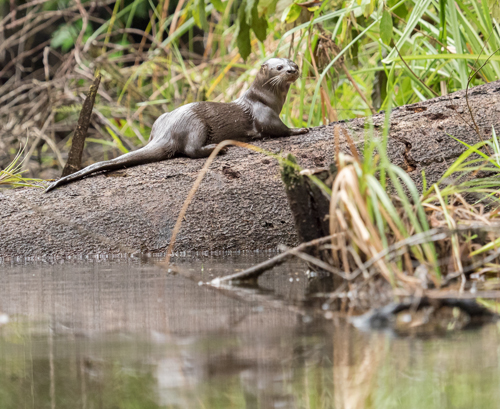
At the end of the day many of us accompanied a guide as he called in, by name, several Spectacled Caimans that he tossed a few fish to, although ‘Ugly Mama’ didn’t appear!
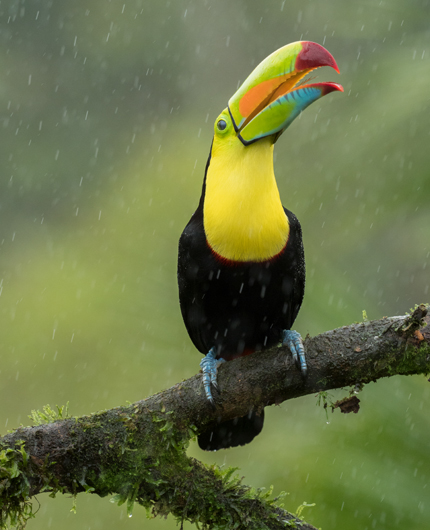
Keel-billed Toucan
Day 6. We packed up and headed towards our next destination, but stopped en route at another spot where we hoped to see one of Central America’s trophy mammals, the Tayra. This is a large Mustelid, a member of the Weasel family that looks a bit like an Otter-Wolverine-Pine Martin mix. The Tayra often comes in for bananas, but this time it only ran on by, and we thought we missed our chance. Incredibly, though, the Tayra instead discovered a paper wasp hive that it raided and destroyed, in full view of us, as wasps hovered around the apparently unfazed Tayra. Great shots!
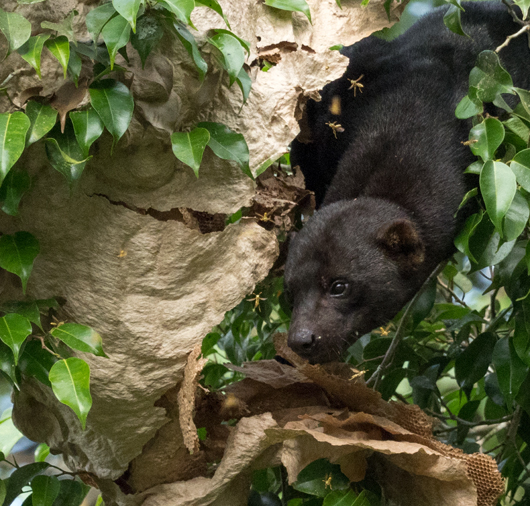
Our host brought out two species of Treefrog, a Banded Jungle and a Red-eyed, which climbed up a thin vine, offering great shots as it purposely strode upwards, each step slow and deliberate. More great shots.
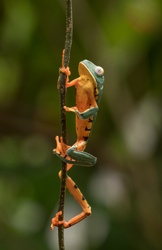
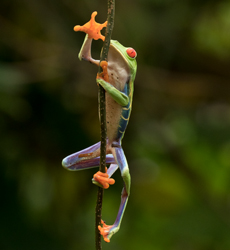
Bird life was good here as well, and we photographed two species of Toucans, Honeycreepers, Woodpeckers, and Oropendolas.
We headed to our next destination, where, en route, we rescued the Three-toed Sloth mentioned earlier. I’m so glad we took the time to transport it the 300 yards to the forest – I doubt if it would have made it through the maze of spikey pineapple plants had we not.
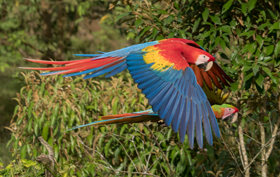 After lunch, we stopped for a great visit at a private ranch where we photographed Scarlet Macaws in flight, and where we had an incredible shoot with White-throated Capuchin Monkeys, that groomed, jumped, and stared at us at close range – the best shoot I’ve ever had of these monkeys.
After lunch, we stopped for a great visit at a private ranch where we photographed Scarlet Macaws in flight, and where we had an incredible shoot with White-throated Capuchin Monkeys, that groomed, jumped, and stared at us at close range – the best shoot I’ve ever had of these monkeys.
By late afternoon we were off to our next destination, where, sadly, we encountered a Danish couple who had just had a bad traffic accident. Somehow, the driver lost control and the SUV rolled, at least once if not several times. He broke his collar 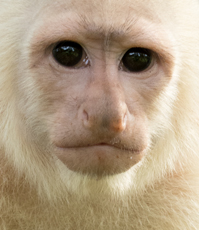 bone, and his girl friend was cut, but otherwise they were healthy but very shaken up. We stayed with them until a lodge manager we knew, and where they had stayed, came to relieve us. We couldn’t do much, except for checking for obvious injuries, but having a comforting presence and support was the best first aid they obviously needed.
bone, and his girl friend was cut, but otherwise they were healthy but very shaken up. We stayed with them until a lodge manager we knew, and where they had stayed, came to relieve us. We couldn’t do much, except for checking for obvious injuries, but having a comforting presence and support was the best first aid they obviously needed.
We arrived at our lodge right before dark.
Day 7. Using our lodge as a base, we headed to another location for a day of High Speed Flash photography of Hummingbirds. The morning started slow, as it always does as birds must find our new feeders, but by the afternoon the shooting was quite productive. Everyone rotated through our three sets, and those not doing so worked the birds that visited some of the other feeders or the flowers that surrounded the location. We worked this site all day.
Day 8. We photographed Hummingbirds at our lodge today. Again, the shooting started a bit slow, but progressively improved throughout the day. I was quite worried, as in all the years we’ve been at this lodge we have never seen so little activity. I think the owner has gotten lazy, as the bird feeders, for Thrushes, Finches, and more, was very much neglected and the shooting there minimal. The Hummingbirds, however, ended up to be quite good, and Hermits, Sabrewings, Brilliants, and more all visited the feeders.
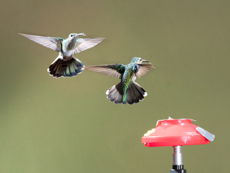
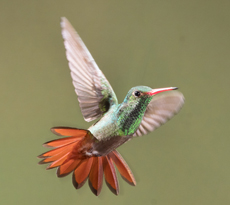
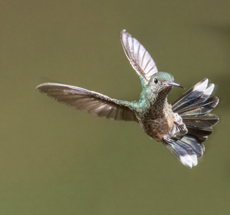
Green-crowned Brilliant; Rufous Hummingbird; Scaly-breasted Hummingbird
The lodge staff is great, and returned to our site repeatedly with macro subjects, including a large Katydid, a tropical Mantid, and a spikey Caterpillar that not only provided good shooting but also reinforced the flash lessons I’d given on balancing ambient light and flash.
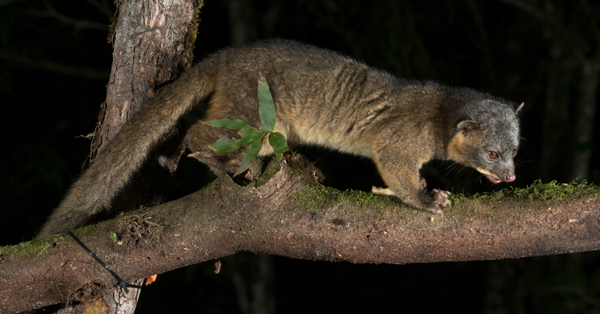
Our guide had seen a rare mammal, an Olinga, a raccoon-relative that resembles a Kinkajou, which some describe as almost primate-like, the previous evening and at the end of the day we had everyone set up to shoot this mammal if it reappeared. Meanwhile, I set up multiple flashes for another uncommon mammal, a Pacca, a striped and spotted rodent that vaguely might resemble a pig or a small deer
We were worried the Olinga would be shy, and when it first arrived it only stayed a minute, but after more cleverly baiting the feeding station it eventually returned, and we got nice shots. Dinner interrupted our shoot, and while we ate I’d check our Pacca setup, watching as one or two ate undisturbed. By the time dinner was over, so was most of the feeding for the Paccas, and I think only one shooter got a shot. I had three Transmitters for the 7 photographers to share, but the Paccas didn’t cooperate. They were full, as our shooters dined!
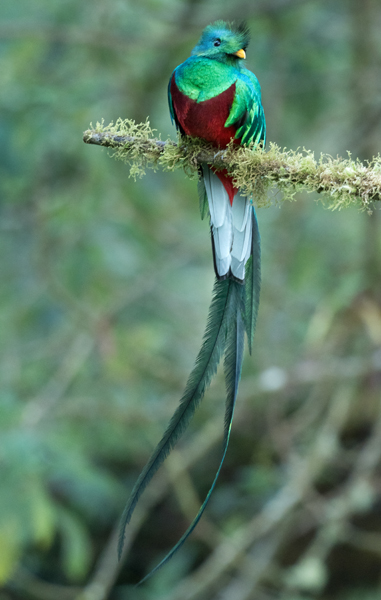 Day 9. We headed to our next stop, high in the mountains where, on our last visit, we froze, as we were totally unprepared for the cold weather. This time, we knew better, and our group was prepared. We arrived in time to do some Hummingbird photography, and for Mary and I to set up one Hummingbird High Speed Flash setup. Birds were VERY slow, and since we didn’t have too much time I used the black wall as our background, creating some very neat shots of birds set up against this. Not the usual background, but different, and striking.
Day 9. We headed to our next stop, high in the mountains where, on our last visit, we froze, as we were totally unprepared for the cold weather. This time, we knew better, and our group was prepared. We arrived in time to do some Hummingbird photography, and for Mary and I to set up one Hummingbird High Speed Flash setup. Birds were VERY slow, and since we didn’t have too much time I used the black wall as our background, creating some very neat shots of birds set up against this. Not the usual background, but different, and striking.
Day 10. We met at 5:30AM for one of the main reasons for being at this lodge – photographing the Resplendent Quetzal. This iconic cloud forest bird is truly spectacular, with back feathers that extend nearly thirty inches, making it look as if it is sporting a long tail. Several farms in the area now cooperate in an ecotourism endeavor, preserving Quetzal habitat while earning cash.
We headed to a farm where several Quetzals visited a wild avocado tree and where the farmer had erected several great perches where, hopefully, a Quetzal would land. One did, multiple times, and we had THE BEST shoot of this bird I’ve ever had. A female, lacking the long tail, also perched in the open, and, at the end of the morning, we had a Collared Redstart and Blackheaded Flycatcher – two mountain species that we did well with.
In the afternoon we rotated through two High Speed Flash setups and natural light shooting of Hummingbirds and other species. The shooting at the setups was slow, but we did manage shots of three new Hummingbird species.
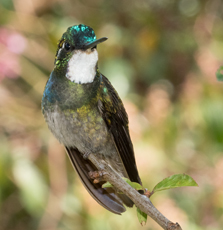 Day 11. After spending the morning photographing hummers and Chlorophonias around the lodge, we left mid-morning for another location for a shoot, where we had great Flame-colored Tanagers, Emerald Toucanets, and the best White-throated Mountain Gem Hummingbirds I’ve ever had.
Day 11. After spending the morning photographing hummers and Chlorophonias around the lodge, we left mid-morning for another location for a shoot, where we had great Flame-colored Tanagers, Emerald Toucanets, and the best White-throated Mountain Gem Hummingbirds I’ve ever had.
Lunch was at a riverside restaurant with some of the best food of the trip – and that is saying a lot, before we headed to another great location for an afternoon shoot. This one was probably one of the best setups we’ve seen for photography, with multiple feeders, a great viewing area with comfortable chairs, and lots of hummingbirds, Tanagers, and Chlorophonias.
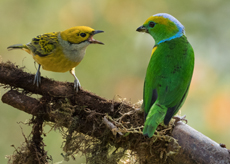 Mary spotted a very tame, and regular, Volcano Hummingbird male, and several of us spent the remainder of the afternoon shooting this bird as it periodically visited flowers nearby, and perched often. I was using the Olympus 300mm with a 1.4X teleconverter, the equivalent of 840mm, and ended up shooting the bird at around 6 feet! I’d never successfully shot this species before, and I won’t have to do so ever again. Great shooting!
Mary spotted a very tame, and regular, Volcano Hummingbird male, and several of us spent the remainder of the afternoon shooting this bird as it periodically visited flowers nearby, and perched often. I was using the Olympus 300mm with a 1.4X teleconverter, the equivalent of 840mm, and ended up shooting the bird at around 6 feet! I’d never successfully shot this species before, and I won’t have to do so ever again. Great shooting!
Left: White-throated Mountain Gem
Silver-throated Tanager and Golden-collared Chlorophonia
Flame-colored Tanager
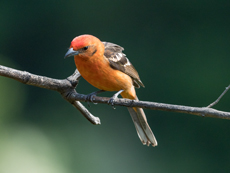 Day 12. We tried again for the Quetzal. Unfortunately, one of our participants had problems with the alarm and as it was time to leave did not appear. Time is of the essence for Quetzals, as they often appear early and then fly off, and I was faced with the hard decision of leaving that person behind, or following a schedule. I followed the schedule, and we arrived in time to get the only Quetzal we photographed that morning. The late-comer arrived 6 minutes after we’d left our lodge, but got a ride from another guide who was bringing his group. The Quetzals remained in the area, but stayed mostly hidden in the avocado tree, and offered no real shots. Had we waited, the group would have missed the only opportunity we had that day, and though Mary and I felt terrible about leaving someone behind, I did what was best for the group.
Day 12. We tried again for the Quetzal. Unfortunately, one of our participants had problems with the alarm and as it was time to leave did not appear. Time is of the essence for Quetzals, as they often appear early and then fly off, and I was faced with the hard decision of leaving that person behind, or following a schedule. I followed the schedule, and we arrived in time to get the only Quetzal we photographed that morning. The late-comer arrived 6 minutes after we’d left our lodge, but got a ride from another guide who was bringing his group. The Quetzals remained in the area, but stayed mostly hidden in the avocado tree, and offered no real shots. Had we waited, the group would have missed the only opportunity we had that day, and though Mary and I felt terrible about leaving someone behind, I did what was best for the group.
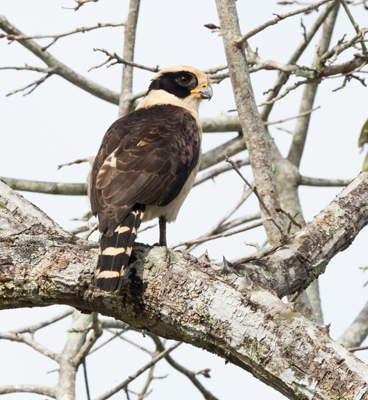 The Quetzal shooting was, of course, anticlimactic after the other day’s shoot, and as we returned to the lodge weather came in, misting and fogging, and making any further photography difficult, and what we call ‘negative shooting,’ since it wouldn’t match with anything we did earlier. With that in mind, after breakfast we decided to head back to San Jose, giving everyone a more restful afternoon and giving all plenty of time to pack for their departures tomorrow.
The Quetzal shooting was, of course, anticlimactic after the other day’s shoot, and as we returned to the lodge weather came in, misting and fogging, and making any further photography difficult, and what we call ‘negative shooting,’ since it wouldn’t match with anything we did earlier. With that in mind, after breakfast we decided to head back to San Jose, giving everyone a more restful afternoon and giving all plenty of time to pack for their departures tomorrow.
Left: Laughing Falcon, 840mm handheld
That evening, at 6, we did our farewell dinner, and reviewed the trip, asking for Trip Highlights, Favorite Shots, etc. I could honest report that this was our best Costa Rica trip ever, and one of the very best and most fun groups we’ve had here. With that, our trip concluded.
Why you should travel with us
Testimonials
Join us on Facebook at: Follow Hoot Hollow
Office Phone: (717) 543-6423
Or FAX us at: (717) 543-5342
Mary and Joe are proud to endorse the Photo Retailer that has
done the absolute most in supporting nature photography in all
its facets ---

Check out the Monthly Specials
from Hunt's
Check out these TPPA specials!

White-faced Capuchin Monkeys

Olingo

Volcano Hummingbird
Costa Rica 2019
Hummingbirds, Birds, and Wildlife Photo Tour
TRIP REPORT
Our January trip was, hands down, the best ever. We had a great group that generated incredible karma – a point our in-country guide commented upon, and our luck was fantastic. Although Mary and I brought two Canon cameras, thinking we’d need them for our Bat photography, we never used any of that gear. Instead, we used our Olympus equipment for all of our shooting, and I think we were a bit envied at times, as our close-focusing abilities, hand-holding 800mm, ProCapture, and the light weight of the gear really shined on this trip.
We visited a few new areas, and had incredible luck with our usual locations. For me, my nemesis has always been Sloths, as our groups have had great luck, while I’ve always been in the wrong place at the right time whenever the group had one. Not this year! Our guide located us in the forest when he found a Three-toed Sloth close to the Park entrance, and while we were filming it, we had another. More on that later.
 For some, and for us surely, one of the highlights was our saving a Three-toed Sloth that was crossing a road around a pineapple plantation. Our guide carried it by its back fur and placed it on a small tree by a fence, but as we assessed the situation I realized that the Sloth would be in serious trouble – any forest was far off, and the sloth would have had to travel through prickly pineapples to get there. So I carried the sloth towards the distant forest, until it got its foreleg positioned to reach back and scrape me with its sharp claws. Luckily, it didn’t break the skin, and after that, I left my more experienced guide to carry the sloth the rest of the way. When we placed it on a tree, the Sloth just calmly looked about, seemingly smiling and thanking us, and appeared to be in no hurry to climb higher. Can you imagine – this alien space travel for the Sloth!
For some, and for us surely, one of the highlights was our saving a Three-toed Sloth that was crossing a road around a pineapple plantation. Our guide carried it by its back fur and placed it on a small tree by a fence, but as we assessed the situation I realized that the Sloth would be in serious trouble – any forest was far off, and the sloth would have had to travel through prickly pineapples to get there. So I carried the sloth towards the distant forest, until it got its foreleg positioned to reach back and scrape me with its sharp claws. Luckily, it didn’t break the skin, and after that, I left my more experienced guide to carry the sloth the rest of the way. When we placed it on a tree, the Sloth just calmly looked about, seemingly smiling and thanking us, and appeared to be in no hurry to climb higher. Can you imagine – this alien space travel for the Sloth!
Here’s the report.
Day 1. Everyone arrived safely, either today or on the preceding day -- which we recommend because of the potential of delays with winter weather. Most photographers spent some time in the gardens at the hotel, and that evening we had our group welcome dinner and an orientation program on the trip.




Free-flying butterflies captured with ProCapture
I spent a portion of the afternoon using ProCapture with my Olympus OMD-E Mark II camera on butterflies. ProCapture records images in a continuous loop when the camera shutter is half-pressed, and, when the shutter is fully depressed, ie the camera fires, the preceeding 14 images are recorded as well. In this way, as butterflies either flew in to a flower, or lifted off, I fired, and each time, of course, my own reaction time was too late. But with ProCapture, I caught butterflies as they were still in flight. Catching focus was another matter -- I had to be lucky for a butterfly to be in the plane of focus, but I did so several times. When I showed images to the group that evening, everyone was stunned ... and very impressed!
 Day 2. This morning we headed north towards Arenal Volcano, the site of our first shoot. Traffic congestion was bad, so we took an alternate route that allowed us to visit a good restaurant where Tree Iguanas are easily photographed from the road and the restaurant’s porch. After lunch, we headed on to Arenal, with an extremely productive stop at a small wildlife sanctuary where we had our first Sloths.
Day 2. This morning we headed north towards Arenal Volcano, the site of our first shoot. Traffic congestion was bad, so we took an alternate route that allowed us to visit a good restaurant where Tree Iguanas are easily photographed from the road and the restaurant’s porch. After lunch, we headed on to Arenal, with an extremely productive stop at a small wildlife sanctuary where we had our first Sloths.
The group was centered at a pond, where we were photographing Spectacled Caiman and Boat-billed Herons, and a great Broad-billed Mot-mot, when our guide found us and directed us to a Sloth, clearly visible in a tree. Over the next hour or so the Sloth moved to two more trees, giving us several shooting opportunities, and while we were shooting it, we discovered a younger Sloth was buried in the vegetation along the trail. That one eventually climbed a vine right over our trail, just feet away, as it descended to do its weekly defecation, which, oddly enough, Sloths always do on the ground. Some leaves gave the Sloth some privacy, and I couldn’t tell if the Sloth dug a hole or not.
We arrived at Arenal at dusk.

Day 3. Today we headed to a private Reptile Zoo for a very productive shoot. The staff had collected a variety of props, and we were able to shoot the snakes, lizards, frogs, and more in very natural-looking habitats. I set up a multi-flash system for several subjects, including the world’s largest species of Pit-Viper, the Bushmaster, as well as Fer-de-Lance, Jumping Vipers, and other snakes. One of the highlights was, of course, the Red-eyed Treefrog, but another was the Bush Viper I set up for a great landscape shot. We shot there all day.





Helmeted Iguana; Eyelash Viper
Jumping Viper; Neotropical Rattlesnake
Fer-de-Lance


Bushmaster; Tree Anole

Arboreal Viper
Day 4. After breakfast we headed to our next location, our favorite lodge in northern Costa Rica not far from the Nicaraguan border. There is a special blind there where King Vultures often arrive at a bait, and photographers earlier in the day had baited and used the blind. Fortunately, in the afternoon it was open, and several of us went in, and had five King Vultures, for some great shooting. The others in the group shot from the porch, where a variety of birds continually visited the feeders.

Day 5. We did two shifts to a local home where we had two flash setups for Hummingbirds. One group went in the morning, alternating their time between the hummingbirds and natural light (with fill flash) shooting of a variety of songbirds visiting a wonderful bait station. The others in the group shot the birds at the lodge, and, in the afternoon, the two groups switched.




White-necked Jacobin and Green-breasted Mango
I did the morning hummingbird shift, giving me the free-time needed to set up for our Bat photography that evening. At 5, our group setup for the bats, and by the time we were finished night had fallen and the bats were flying. We kept our cameras going while we had dinner, and returned for more shooting afterwards, concluding after about 1,000 shots of bats. I used a Range IR to trip the four Phottix Manual flashes I used, and with our Olympus gear, using the Time-Lapse movie feature to advance the frame, Mary and I were able to advance frames without using an electronic release. That proved very successful!
I’m doing a how-to video on our Bat Photography here, which will be available shortly – either here, or from our home page.

Orange-necter feeding Bat


Pallas Long-tongued Bat
Day 5. The AM photographers did the afternoon hummingbird shift, while the PM did the morning. Both shoots went very well. When not shooting at the off-site location, the photographers worked on the Toucans, Tanagers, Woodpeckers, and more that visited the bird feeders at the lodge.




Palm Tanager; Golden-hooded Tanager
Green Honeycreeper; Red-legged Honeycreeper
Yesterday, two of our participants did the optional canoe cruise, and successfully found an Agami Heron, the most beautiful of the Western Hemisphere Herons. This afternoon, another participant did the same cruise, but unfortunately was facing the boatman, not the front of the canoe, when they launched. He asked if he could move and reverse himself, but in doing so he sat on the gunnel and the canoe capsized, spilling him and his gear (one camera and lens, only, luckily) and the boatman, who dunked his cellphone, too. Only later did we learn that he had never been in a canoe before, and was understandably unfamiliar with how unstable a canoe can be.
I launched just minutes later, in a different canoe, and proceeded without disaster. I didn’t see the Agami, but did manage nice shots of a Muscovy Duck and of a Neotropical Otter, a very rare find. 
At the end of the day many of us accompanied a guide as he called in, by name, several Spectacled Caimans that he tossed a few fish to, although ‘Ugly Mama’ didn’t appear!

Keel-billed Toucan
Day 6. We packed up and headed towards our next destination, but stopped en route at another spot where we hoped to see one of Central America’s trophy mammals, the Tayra. This is a large Mustelid, a member of the Weasel family that looks a bit like an Otter-Wolverine-Pine Martin mix. The Tayra often comes in for bananas, but this time it only ran on by, and we thought we missed our chance. Incredibly, though, the Tayra instead discovered a paper wasp hive that it raided and destroyed, in full view of us, as wasps hovered around the apparently unfazed Tayra. Great shots!

Our host brought out two species of Treefrog, a Banded Jungle and a Red-eyed, which climbed up a thin vine, offering great shots as it purposely strode upwards, each step slow and deliberate. More great shots.


Bird life was good here as well, and we photographed two species of Toucans, Honeycreepers, Woodpeckers, and Oropendolas.
We headed to our next destination, where, en route, we rescued the Three-toed Sloth mentioned earlier. I’m so glad we took the time to transport it the 300 yards to the forest – I doubt if it would have made it through the maze of spikey pineapple plants had we not.
 After lunch, we stopped for a great visit at a private ranch where we photographed Scarlet Macaws in flight, and where we had an incredible shoot with White-throated Capuchin Monkeys, that groomed, jumped, and stared at us at close range – the best shoot I’ve ever had of these monkeys.
After lunch, we stopped for a great visit at a private ranch where we photographed Scarlet Macaws in flight, and where we had an incredible shoot with White-throated Capuchin Monkeys, that groomed, jumped, and stared at us at close range – the best shoot I’ve ever had of these monkeys.
By late afternoon we were off to our next destination, where, sadly, we encountered a Danish couple who had just had a bad traffic accident. Somehow, the driver lost control and the SUV rolled, at least once if not several times. He broke his collar  bone, and his girl friend was cut, but otherwise they were healthy but very shaken up. We stayed with them until a lodge manager we knew, and where they had stayed, came to relieve us. We couldn’t do much, except for checking for obvious injuries, but having a comforting presence and support was the best first aid they obviously needed.
bone, and his girl friend was cut, but otherwise they were healthy but very shaken up. We stayed with them until a lodge manager we knew, and where they had stayed, came to relieve us. We couldn’t do much, except for checking for obvious injuries, but having a comforting presence and support was the best first aid they obviously needed.
We arrived at our lodge right before dark.
Day 7. Using our lodge as a base, we headed to another location for a day of High Speed Flash photography of Hummingbirds. The morning started slow, as it always does as birds must find our new feeders, but by the afternoon the shooting was quite productive. Everyone rotated through our three sets, and those not doing so worked the birds that visited some of the other feeders or the flowers that surrounded the location. We worked this site all day.
Day 8. We photographed Hummingbirds at our lodge today. Again, the shooting started a bit slow, but progressively improved throughout the day. I was quite worried, as in all the years we’ve been at this lodge we have never seen so little activity. I think the owner has gotten lazy, as the bird feeders, for Thrushes, Finches, and more, was very much neglected and the shooting there minimal. The Hummingbirds, however, ended up to be quite good, and Hermits, Sabrewings, Brilliants, and more all visited the feeders.



Green-crowned Brilliant; Rufous Hummingbird; Scaly-breasted Hummingbird
The lodge staff is great, and returned to our site repeatedly with macro subjects, including a large Katydid, a tropical Mantid, and a spikey Caterpillar that not only provided good shooting but also reinforced the flash lessons I’d given on balancing ambient light and flash.

Our guide had seen a rare mammal, an Olinga, a raccoon-relative that resembles a Kinkajou, which some describe as almost primate-like, the previous evening and at the end of the day we had everyone set up to shoot this mammal if it reappeared. Meanwhile, I set up multiple flashes for another uncommon mammal, a Pacca, a striped and spotted rodent that vaguely might resemble a pig or a small deer
We were worried the Olinga would be shy, and when it first arrived it only stayed a minute, but after more cleverly baiting the feeding station it eventually returned, and we got nice shots. Dinner interrupted our shoot, and while we ate I’d check our Pacca setup, watching as one or two ate undisturbed. By the time dinner was over, so was most of the feeding for the Paccas, and I think only one shooter got a shot. I had three Transmitters for the 7 photographers to share, but the Paccas didn’t cooperate. They were full, as our shooters dined!
 Day 9. We headed to our next stop, high in the mountains where, on our last visit, we froze, as we were totally unprepared for the cold weather. This time, we knew better, and our group was prepared. We arrived in time to do some Hummingbird photography, and for Mary and I to set up one Hummingbird High Speed Flash setup. Birds were VERY slow, and since we didn’t have too much time I used the black wall as our background, creating some very neat shots of birds set up against this. Not the usual background, but different, and striking.
Day 9. We headed to our next stop, high in the mountains where, on our last visit, we froze, as we were totally unprepared for the cold weather. This time, we knew better, and our group was prepared. We arrived in time to do some Hummingbird photography, and for Mary and I to set up one Hummingbird High Speed Flash setup. Birds were VERY slow, and since we didn’t have too much time I used the black wall as our background, creating some very neat shots of birds set up against this. Not the usual background, but different, and striking.
Day 10. We met at 5:30AM for one of the main reasons for being at this lodge – photographing the Resplendent Quetzal. This iconic cloud forest bird is truly spectacular, with back feathers that extend nearly thirty inches, making it look as if it is sporting a long tail. Several farms in the area now cooperate in an ecotourism endeavor, preserving Quetzal habitat while earning cash.
We headed to a farm where several Quetzals visited a wild avocado tree and where the farmer had erected several great perches where, hopefully, a Quetzal would land. One did, multiple times, and we had THE BEST shoot of this bird I’ve ever had. A female, lacking the long tail, also perched in the open, and, at the end of the morning, we had a Collared Redstart and Blackheaded Flycatcher – two mountain species that we did well with.
In the afternoon we rotated through two High Speed Flash setups and natural light shooting of Hummingbirds and other species. The shooting at the setups was slow, but we did manage shots of three new Hummingbird species.
 Day 11. After spending the morning photographing hummers and Chlorophonias around the lodge, we left mid-morning for another location for a shoot, where we had great Flame-colored Tanagers, Emerald Toucanets, and the best White-throated Mountain Gem Hummingbirds I’ve ever had.
Day 11. After spending the morning photographing hummers and Chlorophonias around the lodge, we left mid-morning for another location for a shoot, where we had great Flame-colored Tanagers, Emerald Toucanets, and the best White-throated Mountain Gem Hummingbirds I’ve ever had.
Lunch was at a riverside restaurant with some of the best food of the trip – and that is saying a lot, before we headed to another great location for an afternoon shoot. This one was probably one of the best setups we’ve seen for photography, with multiple feeders, a great viewing area with comfortable chairs, and lots of hummingbirds, Tanagers, and Chlorophonias.
 Mary spotted a very tame, and regular, Volcano Hummingbird male, and several of us spent the remainder of the afternoon shooting this bird as it periodically visited flowers nearby, and perched often. I was using the Olympus 300mm with a 1.4X teleconverter, the equivalent of 840mm, and ended up shooting the bird at around 6 feet! I’d never successfully shot this species before, and I won’t have to do so ever again. Great shooting!
Mary spotted a very tame, and regular, Volcano Hummingbird male, and several of us spent the remainder of the afternoon shooting this bird as it periodically visited flowers nearby, and perched often. I was using the Olympus 300mm with a 1.4X teleconverter, the equivalent of 840mm, and ended up shooting the bird at around 6 feet! I’d never successfully shot this species before, and I won’t have to do so ever again. Great shooting!
Left: White-throated Mountain Gem
Silver-throated Tanager and Golden-collared Chlorophonia
Flame-colored Tanager
 Day 12. We tried again for the Quetzal. Unfortunately, one of our participants had problems with the alarm and as it was time to leave did not appear. Time is of the essence for Quetzals, as they often appear early and then fly off, and I was faced with the hard decision of leaving that person behind, or following a schedule. I followed the schedule, and we arrived in time to get the only Quetzal we photographed that morning. The late-comer arrived 6 minutes after we’d left our lodge, but got a ride from another guide who was bringing his group. The Quetzals remained in the area, but stayed mostly hidden in the avocado tree, and offered no real shots. Had we waited, the group would have missed the only opportunity we had that day, and though Mary and I felt terrible about leaving someone behind, I did what was best for the group.
Day 12. We tried again for the Quetzal. Unfortunately, one of our participants had problems with the alarm and as it was time to leave did not appear. Time is of the essence for Quetzals, as they often appear early and then fly off, and I was faced with the hard decision of leaving that person behind, or following a schedule. I followed the schedule, and we arrived in time to get the only Quetzal we photographed that morning. The late-comer arrived 6 minutes after we’d left our lodge, but got a ride from another guide who was bringing his group. The Quetzals remained in the area, but stayed mostly hidden in the avocado tree, and offered no real shots. Had we waited, the group would have missed the only opportunity we had that day, and though Mary and I felt terrible about leaving someone behind, I did what was best for the group.
 The Quetzal shooting was, of course, anticlimactic after the other day’s shoot, and as we returned to the lodge weather came in, misting and fogging, and making any further photography difficult, and what we call ‘negative shooting,’ since it wouldn’t match with anything we did earlier. With that in mind, after breakfast we decided to head back to San Jose, giving everyone a more restful afternoon and giving all plenty of time to pack for their departures tomorrow.
The Quetzal shooting was, of course, anticlimactic after the other day’s shoot, and as we returned to the lodge weather came in, misting and fogging, and making any further photography difficult, and what we call ‘negative shooting,’ since it wouldn’t match with anything we did earlier. With that in mind, after breakfast we decided to head back to San Jose, giving everyone a more restful afternoon and giving all plenty of time to pack for their departures tomorrow.
Left: Laughing Falcon, 840mm handheld
That evening, at 6, we did our farewell dinner, and reviewed the trip, asking for Trip Highlights, Favorite Shots, etc. I could honest report that this was our best Costa Rica trip ever, and one of the very best and most fun groups we’ve had here. With that, our trip concluded.
Why you should travel with us
Testimonials
Join us on Facebook at: Follow Hoot Hollow
Office Phone: (717) 543-6423
Or FAX us at: (717) 543-5342
Mary and Joe are proud to endorse the Photo Retailer that has
done the absolute most in supporting nature photography in all
its facets ---

Check out the Monthly Specials
from Hunt's
Check out these TPPA specials!

White-faced Capuchin Monkeys

Olingo

Volcano Hummingbird
Costa Rica 2019
Hummingbirds, Birds, and Wildlife Photo Tour
TRIP REPORT
Our January trip was, hands down, the best ever. We had a great group that generated incredible karma – a point our in-country guide commented upon, and our luck was fantastic. Although Mary and I brought two Canon cameras, thinking we’d need them for our Bat photography, we never used any of that gear. Instead, we used our Olympus equipment for all of our shooting, and I think we were a bit envied at times, as our close-focusing abilities, hand-holding 800mm, ProCapture, and the light weight of the gear really shined on this trip.
We visited a few new areas, and had incredible luck with our usual locations. For me, my nemesis has always been Sloths, as our groups have had great luck, while I’ve always been in the wrong place at the right time whenever the group had one. Not this year! Our guide located us in the forest when he found a Three-toed Sloth close to the Park entrance, and while we were filming it, we had another. More on that later.
 For some, and for us surely, one of the highlights was our saving a Three-toed Sloth that was crossing a road around a pineapple plantation. Our guide carried it by its back fur and placed it on a small tree by a fence, but as we assessed the situation I realized that the Sloth would be in serious trouble – any forest was far off, and the sloth would have had to travel through prickly pineapples to get there. So I carried the sloth towards the distant forest, until it got its foreleg positioned to reach back and scrape me with its sharp claws. Luckily, it didn’t break the skin, and after that, I left my more experienced guide to carry the sloth the rest of the way. When we placed it on a tree, the Sloth just calmly looked about, seemingly smiling and thanking us, and appeared to be in no hurry to climb higher. Can you imagine – this alien space travel for the Sloth!
For some, and for us surely, one of the highlights was our saving a Three-toed Sloth that was crossing a road around a pineapple plantation. Our guide carried it by its back fur and placed it on a small tree by a fence, but as we assessed the situation I realized that the Sloth would be in serious trouble – any forest was far off, and the sloth would have had to travel through prickly pineapples to get there. So I carried the sloth towards the distant forest, until it got its foreleg positioned to reach back and scrape me with its sharp claws. Luckily, it didn’t break the skin, and after that, I left my more experienced guide to carry the sloth the rest of the way. When we placed it on a tree, the Sloth just calmly looked about, seemingly smiling and thanking us, and appeared to be in no hurry to climb higher. Can you imagine – this alien space travel for the Sloth!
Here’s the report.
Day 1. Everyone arrived safely, either today or on the preceding day -- which we recommend because of the potential of delays with winter weather. Most photographers spent some time in the gardens at the hotel, and that evening we had our group welcome dinner and an orientation program on the trip.




Free-flying butterflies captured with ProCapture
I spent a portion of the afternoon using ProCapture with my Olympus OMD-E Mark II camera on butterflies. ProCapture records images in a continuous loop when the camera shutter is half-pressed, and, when the shutter is fully depressed, ie the camera fires, the preceeding 14 images are recorded as well. In this way, as butterflies either flew in to a flower, or lifted off, I fired, and each time, of course, my own reaction time was too late. But with ProCapture, I caught butterflies as they were still in flight. Catching focus was another matter -- I had to be lucky for a butterfly to be in the plane of focus, but I did so several times. When I showed images to the group that evening, everyone was stunned ... and very impressed!
 Day 2. This morning we headed north towards Arenal Volcano, the site of our first shoot. Traffic congestion was bad, so we took an alternate route that allowed us to visit a good restaurant where Tree Iguanas are easily photographed from the road and the restaurant’s porch. After lunch, we headed on to Arenal, with an extremely productive stop at a small wildlife sanctuary where we had our first Sloths.
Day 2. This morning we headed north towards Arenal Volcano, the site of our first shoot. Traffic congestion was bad, so we took an alternate route that allowed us to visit a good restaurant where Tree Iguanas are easily photographed from the road and the restaurant’s porch. After lunch, we headed on to Arenal, with an extremely productive stop at a small wildlife sanctuary where we had our first Sloths.
The group was centered at a pond, where we were photographing Spectacled Caiman and Boat-billed Herons, and a great Broad-billed Mot-mot, when our guide found us and directed us to a Sloth, clearly visible in a tree. Over the next hour or so the Sloth moved to two more trees, giving us several shooting opportunities, and while we were shooting it, we discovered a younger Sloth was buried in the vegetation along the trail. That one eventually climbed a vine right over our trail, just feet away, as it descended to do its weekly defecation, which, oddly enough, Sloths always do on the ground. Some leaves gave the Sloth some privacy, and I couldn’t tell if the Sloth dug a hole or not.
We arrived at Arenal at dusk.

Day 3. Today we headed to a private Reptile Zoo for a very productive shoot. The staff had collected a variety of props, and we were able to shoot the snakes, lizards, frogs, and more in very natural-looking habitats. I set up a multi-flash system for several subjects, including the world’s largest species of Pit-Viper, the Bushmaster, as well as Fer-de-Lance, Jumping Vipers, and other snakes. One of the highlights was, of course, the Red-eyed Treefrog, but another was the Bush Viper I set up for a great landscape shot. We shot there all day.





Helmeted Iguana; Eyelash Viper
Jumping Viper; Neotropical Rattlesnake
Fer-de-Lance


Bushmaster; Tree Anole

Arboreal Viper
Day 4. After breakfast we headed to our next location, our favorite lodge in northern Costa Rica not far from the Nicaraguan border. There is a special blind there where King Vultures often arrive at a bait, and photographers earlier in the day had baited and used the blind. Fortunately, in the afternoon it was open, and several of us went in, and had five King Vultures, for some great shooting. The others in the group shot from the porch, where a variety of birds continually visited the feeders.

Day 5. We did two shifts to a local home where we had two flash setups for Hummingbirds. One group went in the morning, alternating their time between the hummingbirds and natural light (with fill flash) shooting of a variety of songbirds visiting a wonderful bait station. The others in the group shot the birds at the lodge, and, in the afternoon, the two groups switched.




White-necked Jacobin and Green-breasted Mango
I did the morning hummingbird shift, giving me the free-time needed to set up for our Bat photography that evening. At 5, our group setup for the bats, and by the time we were finished night had fallen and the bats were flying. We kept our cameras going while we had dinner, and returned for more shooting afterwards, concluding after about 1,000 shots of bats. I used a Range IR to trip the four Phottix Manual flashes I used, and with our Olympus gear, using the Time-Lapse movie feature to advance the frame, Mary and I were able to advance frames without using an electronic release. That proved very successful!
I’m doing a how-to video on our Bat Photography here, which will be available shortly – either here, or from our home page.

Orange-necter feeding Bat


Pallas Long-tongued Bat
Day 5. The AM photographers did the afternoon hummingbird shift, while the PM did the morning. Both shoots went very well. When not shooting at the off-site location, the photographers worked on the Toucans, Tanagers, Woodpeckers, and more that visited the bird feeders at the lodge.




Palm Tanager; Golden-hooded Tanager
Green Honeycreeper; Red-legged Honeycreeper
Yesterday, two of our participants did the optional canoe cruise, and successfully found an Agami Heron, the most beautiful of the Western Hemisphere Herons. This afternoon, another participant did the same cruise, but unfortunately was facing the boatman, not the front of the canoe, when they launched. He asked if he could move and reverse himself, but in doing so he sat on the gunnel and the canoe capsized, spilling him and his gear (one camera and lens, only, luckily) and the boatman, who dunked his cellphone, too. Only later did we learn that he had never been in a canoe before, and was understandably unfamiliar with how unstable a canoe can be.
I launched just minutes later, in a different canoe, and proceeded without disaster. I didn’t see the Agami, but did manage nice shots of a Muscovy Duck and of a Neotropical Otter, a very rare find. 
At the end of the day many of us accompanied a guide as he called in, by name, several Spectacled Caimans that he tossed a few fish to, although ‘Ugly Mama’ didn’t appear!

Keel-billed Toucan
Day 6. We packed up and headed towards our next destination, but stopped en route at another spot where we hoped to see one of Central America’s trophy mammals, the Tayra. This is a large Mustelid, a member of the Weasel family that looks a bit like an Otter-Wolverine-Pine Martin mix. The Tayra often comes in for bananas, but this time it only ran on by, and we thought we missed our chance. Incredibly, though, the Tayra instead discovered a paper wasp hive that it raided and destroyed, in full view of us, as wasps hovered around the apparently unfazed Tayra. Great shots!

Our host brought out two species of Treefrog, a Banded Jungle and a Red-eyed, which climbed up a thin vine, offering great shots as it purposely strode upwards, each step slow and deliberate. More great shots.


Bird life was good here as well, and we photographed two species of Toucans, Honeycreepers, Woodpeckers, and Oropendolas.
We headed to our next destination, where, en route, we rescued the Three-toed Sloth mentioned earlier. I’m so glad we took the time to transport it the 300 yards to the forest – I doubt if it would have made it through the maze of spikey pineapple plants had we not.
 After lunch, we stopped for a great visit at a private ranch where we photographed Scarlet Macaws in flight, and where we had an incredible shoot with White-throated Capuchin Monkeys, that groomed, jumped, and stared at us at close range – the best shoot I’ve ever had of these monkeys.
After lunch, we stopped for a great visit at a private ranch where we photographed Scarlet Macaws in flight, and where we had an incredible shoot with White-throated Capuchin Monkeys, that groomed, jumped, and stared at us at close range – the best shoot I’ve ever had of these monkeys.
By late afternoon we were off to our next destination, where, sadly, we encountered a Danish couple who had just had a bad traffic accident. Somehow, the driver lost control and the SUV rolled, at least once if not several times. He broke his collar  bone, and his girl friend was cut, but otherwise they were healthy but very shaken up. We stayed with them until a lodge manager we knew, and where they had stayed, came to relieve us. We couldn’t do much, except for checking for obvious injuries, but having a comforting presence and support was the best first aid they obviously needed.
bone, and his girl friend was cut, but otherwise they were healthy but very shaken up. We stayed with them until a lodge manager we knew, and where they had stayed, came to relieve us. We couldn’t do much, except for checking for obvious injuries, but having a comforting presence and support was the best first aid they obviously needed.
We arrived at our lodge right before dark.
Day 7. Using our lodge as a base, we headed to another location for a day of High Speed Flash photography of Hummingbirds. The morning started slow, as it always does as birds must find our new feeders, but by the afternoon the shooting was quite productive. Everyone rotated through our three sets, and those not doing so worked the birds that visited some of the other feeders or the flowers that surrounded the location. We worked this site all day.
Day 8. We photographed Hummingbirds at our lodge today. Again, the shooting started a bit slow, but progressively improved throughout the day. I was quite worried, as in all the years we’ve been at this lodge we have never seen so little activity. I think the owner has gotten lazy, as the bird feeders, for Thrushes, Finches, and more, was very much neglected and the shooting there minimal. The Hummingbirds, however, ended up to be quite good, and Hermits, Sabrewings, Brilliants, and more all visited the feeders.



Green-crowned Brilliant; Rufous Hummingbird; Scaly-breasted Hummingbird
The lodge staff is great, and returned to our site repeatedly with macro subjects, including a large Katydid, a tropical Mantid, and a spikey Caterpillar that not only provided good shooting but also reinforced the flash lessons I’d given on balancing ambient light and flash.

Our guide had seen a rare mammal, an Olinga, a raccoon-relative that resembles a Kinkajou, which some describe as almost primate-like, the previous evening and at the end of the day we had everyone set up to shoot this mammal if it reappeared. Meanwhile, I set up multiple flashes for another uncommon mammal, a Pacca, a striped and spotted rodent that vaguely might resemble a pig or a small deer
We were worried the Olinga would be shy, and when it first arrived it only stayed a minute, but after more cleverly baiting the feeding station it eventually returned, and we got nice shots. Dinner interrupted our shoot, and while we ate I’d check our Pacca setup, watching as one or two ate undisturbed. By the time dinner was over, so was most of the feeding for the Paccas, and I think only one shooter got a shot. I had three Transmitters for the 7 photographers to share, but the Paccas didn’t cooperate. They were full, as our shooters dined!
 Day 9. We headed to our next stop, high in the mountains where, on our last visit, we froze, as we were totally unprepared for the cold weather. This time, we knew better, and our group was prepared. We arrived in time to do some Hummingbird photography, and for Mary and I to set up one Hummingbird High Speed Flash setup. Birds were VERY slow, and since we didn’t have too much time I used the black wall as our background, creating some very neat shots of birds set up against this. Not the usual background, but different, and striking.
Day 9. We headed to our next stop, high in the mountains where, on our last visit, we froze, as we were totally unprepared for the cold weather. This time, we knew better, and our group was prepared. We arrived in time to do some Hummingbird photography, and for Mary and I to set up one Hummingbird High Speed Flash setup. Birds were VERY slow, and since we didn’t have too much time I used the black wall as our background, creating some very neat shots of birds set up against this. Not the usual background, but different, and striking.
Day 10. We met at 5:30AM for one of the main reasons for being at this lodge – photographing the Resplendent Quetzal. This iconic cloud forest bird is truly spectacular, with back feathers that extend nearly thirty inches, making it look as if it is sporting a long tail. Several farms in the area now cooperate in an ecotourism endeavor, preserving Quetzal habitat while earning cash.
We headed to a farm where several Quetzals visited a wild avocado tree and where the farmer had erected several great perches where, hopefully, a Quetzal would land. One did, multiple times, and we had THE BEST shoot of this bird I’ve ever had. A female, lacking the long tail, also perched in the open, and, at the end of the morning, we had a Collared Redstart and Blackheaded Flycatcher – two mountain species that we did well with.
In the afternoon we rotated through two High Speed Flash setups and natural light shooting of Hummingbirds and other species. The shooting at the setups was slow, but we did manage shots of three new Hummingbird species.
 Day 11. After spending the morning photographing hummers and Chlorophonias around the lodge, we left mid-morning for another location for a shoot, where we had great Flame-colored Tanagers, Emerald Toucanets, and the best White-throated Mountain Gem Hummingbirds I’ve ever had.
Day 11. After spending the morning photographing hummers and Chlorophonias around the lodge, we left mid-morning for another location for a shoot, where we had great Flame-colored Tanagers, Emerald Toucanets, and the best White-throated Mountain Gem Hummingbirds I’ve ever had.
Lunch was at a riverside restaurant with some of the best food of the trip – and that is saying a lot, before we headed to another great location for an afternoon shoot. This one was probably one of the best setups we’ve seen for photography, with multiple feeders, a great viewing area with comfortable chairs, and lots of hummingbirds, Tanagers, and Chlorophonias.
 Mary spotted a very tame, and regular, Volcano Hummingbird male, and several of us spent the remainder of the afternoon shooting this bird as it periodically visited flowers nearby, and perched often. I was using the Olympus 300mm with a 1.4X teleconverter, the equivalent of 840mm, and ended up shooting the bird at around 6 feet! I’d never successfully shot this species before, and I won’t have to do so ever again. Great shooting!
Mary spotted a very tame, and regular, Volcano Hummingbird male, and several of us spent the remainder of the afternoon shooting this bird as it periodically visited flowers nearby, and perched often. I was using the Olympus 300mm with a 1.4X teleconverter, the equivalent of 840mm, and ended up shooting the bird at around 6 feet! I’d never successfully shot this species before, and I won’t have to do so ever again. Great shooting!
Left: White-throated Mountain Gem
Silver-throated Tanager and Golden-collared Chlorophonia
Flame-colored Tanager
 Day 12. We tried again for the Quetzal. Unfortunately, one of our participants had problems with the alarm and as it was time to leave did not appear. Time is of the essence for Quetzals, as they often appear early and then fly off, and I was faced with the hard decision of leaving that person behind, or following a schedule. I followed the schedule, and we arrived in time to get the only Quetzal we photographed that morning. The late-comer arrived 6 minutes after we’d left our lodge, but got a ride from another guide who was bringing his group. The Quetzals remained in the area, but stayed mostly hidden in the avocado tree, and offered no real shots. Had we waited, the group would have missed the only opportunity we had that day, and though Mary and I felt terrible about leaving someone behind, I did what was best for the group.
Day 12. We tried again for the Quetzal. Unfortunately, one of our participants had problems with the alarm and as it was time to leave did not appear. Time is of the essence for Quetzals, as they often appear early and then fly off, and I was faced with the hard decision of leaving that person behind, or following a schedule. I followed the schedule, and we arrived in time to get the only Quetzal we photographed that morning. The late-comer arrived 6 minutes after we’d left our lodge, but got a ride from another guide who was bringing his group. The Quetzals remained in the area, but stayed mostly hidden in the avocado tree, and offered no real shots. Had we waited, the group would have missed the only opportunity we had that day, and though Mary and I felt terrible about leaving someone behind, I did what was best for the group.
 The Quetzal shooting was, of course, anticlimactic after the other day’s shoot, and as we returned to the lodge weather came in, misting and fogging, and making any further photography difficult, and what we call ‘negative shooting,’ since it wouldn’t match with anything we did earlier. With that in mind, after breakfast we decided to head back to San Jose, giving everyone a more restful afternoon and giving all plenty of time to pack for their departures tomorrow.
The Quetzal shooting was, of course, anticlimactic after the other day’s shoot, and as we returned to the lodge weather came in, misting and fogging, and making any further photography difficult, and what we call ‘negative shooting,’ since it wouldn’t match with anything we did earlier. With that in mind, after breakfast we decided to head back to San Jose, giving everyone a more restful afternoon and giving all plenty of time to pack for their departures tomorrow.
Left: Laughing Falcon, 840mm handheld
That evening, at 6, we did our farewell dinner, and reviewed the trip, asking for Trip Highlights, Favorite Shots, etc. I could honest report that this was our best Costa Rica trip ever, and one of the very best and most fun groups we’ve had here. With that, our trip concluded.
Why you should travel with us
Testimonials
Join us on Facebook at: Follow Hoot Hollow
Office Phone: (717) 543-6423
Or FAX us at: (717) 543-5342
Mary and Joe are proud to endorse the Photo Retailer that has
done the absolute most in supporting nature photography in all
its facets ---

Check out the Monthly Specials
from Hunt's
Check out these TPPA specials!

White-faced Capuchin Monkeys

Olingo

Volcano Hummingbird
Costa Rica 2019
Hummingbirds, Birds, and Wildlife Photo Tour
TRIP REPORT
Our January trip was, hands down, the best ever. We had a great group that generated incredible karma – a point our in-country guide commented upon, and our luck was fantastic. Although Mary and I brought two Canon cameras, thinking we’d need them for our Bat photography, we never used any of that gear. Instead, we used our Olympus equipment for all of our shooting, and I think we were a bit envied at times, as our close-focusing abilities, hand-holding 800mm, ProCapture, and the light weight of the gear really shined on this trip.
We visited a few new areas, and had incredible luck with our usual locations. For me, my nemesis has always been Sloths, as our groups have had great luck, while I’ve always been in the wrong place at the right time whenever the group had one. Not this year! Our guide located us in the forest when he found a Three-toed Sloth close to the Park entrance, and while we were filming it, we had another. More on that later.
 For some, and for us surely, one of the highlights was our saving a Three-toed Sloth that was crossing a road around a pineapple plantation. Our guide carried it by its back fur and placed it on a small tree by a fence, but as we assessed the situation I realized that the Sloth would be in serious trouble – any forest was far off, and the sloth would have had to travel through prickly pineapples to get there. So I carried the sloth towards the distant forest, until it got its foreleg positioned to reach back and scrape me with its sharp claws. Luckily, it didn’t break the skin, and after that, I left my more experienced guide to carry the sloth the rest of the way. When we placed it on a tree, the Sloth just calmly looked about, seemingly smiling and thanking us, and appeared to be in no hurry to climb higher. Can you imagine – this alien space travel for the Sloth!
For some, and for us surely, one of the highlights was our saving a Three-toed Sloth that was crossing a road around a pineapple plantation. Our guide carried it by its back fur and placed it on a small tree by a fence, but as we assessed the situation I realized that the Sloth would be in serious trouble – any forest was far off, and the sloth would have had to travel through prickly pineapples to get there. So I carried the sloth towards the distant forest, until it got its foreleg positioned to reach back and scrape me with its sharp claws. Luckily, it didn’t break the skin, and after that, I left my more experienced guide to carry the sloth the rest of the way. When we placed it on a tree, the Sloth just calmly looked about, seemingly smiling and thanking us, and appeared to be in no hurry to climb higher. Can you imagine – this alien space travel for the Sloth!
Here’s the report.
Day 1. Everyone arrived safely, either today or on the preceding day -- which we recommend because of the potential of delays with winter weather. Most photographers spent some time in the gardens at the hotel, and that evening we had our group welcome dinner and an orientation program on the trip.




Free-flying butterflies captured with ProCapture
I spent a portion of the afternoon using ProCapture with my Olympus OMD-E Mark II camera on butterflies. ProCapture records images in a continuous loop when the camera shutter is half-pressed, and, when the shutter is fully depressed, ie the camera fires, the preceeding 14 images are recorded as well. In this way, as butterflies either flew in to a flower, or lifted off, I fired, and each time, of course, my own reaction time was too late. But with ProCapture, I caught butterflies as they were still in flight. Catching focus was another matter -- I had to be lucky for a butterfly to be in the plane of focus, but I did so several times. When I showed images to the group that evening, everyone was stunned ... and very impressed!
 Day 2. This morning we headed north towards Arenal Volcano, the site of our first shoot. Traffic congestion was bad, so we took an alternate route that allowed us to visit a good restaurant where Tree Iguanas are easily photographed from the road and the restaurant’s porch. After lunch, we headed on to Arenal, with an extremely productive stop at a small wildlife sanctuary where we had our first Sloths.
Day 2. This morning we headed north towards Arenal Volcano, the site of our first shoot. Traffic congestion was bad, so we took an alternate route that allowed us to visit a good restaurant where Tree Iguanas are easily photographed from the road and the restaurant’s porch. After lunch, we headed on to Arenal, with an extremely productive stop at a small wildlife sanctuary where we had our first Sloths.
The group was centered at a pond, where we were photographing Spectacled Caiman and Boat-billed Herons, and a great Broad-billed Mot-mot, when our guide found us and directed us to a Sloth, clearly visible in a tree. Over the next hour or so the Sloth moved to two more trees, giving us several shooting opportunities, and while we were shooting it, we discovered a younger Sloth was buried in the vegetation along the trail. That one eventually climbed a vine right over our trail, just feet away, as it descended to do its weekly defecation, which, oddly enough, Sloths always do on the ground. Some leaves gave the Sloth some privacy, and I couldn’t tell if the Sloth dug a hole or not.
We arrived at Arenal at dusk.

Day 3. Today we headed to a private Reptile Zoo for a very productive shoot. The staff had collected a variety of props, and we were able to shoot the snakes, lizards, frogs, and more in very natural-looking habitats. I set up a multi-flash system for several subjects, including the world’s largest species of Pit-Viper, the Bushmaster, as well as Fer-de-Lance, Jumping Vipers, and other snakes. One of the highlights was, of course, the Red-eyed Treefrog, but another was the Bush Viper I set up for a great landscape shot. We shot there all day.





Helmeted Iguana; Eyelash Viper
Jumping Viper; Neotropical Rattlesnake
Fer-de-Lance


Bushmaster; Tree Anole

Arboreal Viper
Day 4. After breakfast we headed to our next location, our favorite lodge in northern Costa Rica not far from the Nicaraguan border. There is a special blind there where King Vultures often arrive at a bait, and photographers earlier in the day had baited and used the blind. Fortunately, in the afternoon it was open, and several of us went in, and had five King Vultures, for some great shooting. The others in the group shot from the porch, where a variety of birds continually visited the feeders.

Day 5. We did two shifts to a local home where we had two flash setups for Hummingbirds. One group went in the morning, alternating their time between the hummingbirds and natural light (with fill flash) shooting of a variety of songbirds visiting a wonderful bait station. The others in the group shot the birds at the lodge, and, in the afternoon, the two groups switched.




White-necked Jacobin and Green-breasted Mango
I did the morning hummingbird shift, giving me the free-time needed to set up for our Bat photography that evening. At 5, our group setup for the bats, and by the time we were finished night had fallen and the bats were flying. We kept our cameras going while we had dinner, and returned for more shooting afterwards, concluding after about 1,000 shots of bats. I used a Range IR to trip the four Phottix Manual flashes I used, and with our Olympus gear, using the Time-Lapse movie feature to advance the frame, Mary and I were able to advance frames without using an electronic release. That proved very successful!
I’m doing a how-to video on our Bat Photography here, which will be available shortly – either here, or from our home page.

Orange-necter feeding Bat


Pallas Long-tongued Bat
Day 5. The AM photographers did the afternoon hummingbird shift, while the PM did the morning. Both shoots went very well. When not shooting at the off-site location, the photographers worked on the Toucans, Tanagers, Woodpeckers, and more that visited the bird feeders at the lodge.




Palm Tanager; Golden-hooded Tanager
Green Honeycreeper; Red-legged Honeycreeper
Yesterday, two of our participants did the optional canoe cruise, and successfully found an Agami Heron, the most beautiful of the Western Hemisphere Herons. This afternoon, another participant did the same cruise, but unfortunately was facing the boatman, not the front of the canoe, when they launched. He asked if he could move and reverse himself, but in doing so he sat on the gunnel and the canoe capsized, spilling him and his gear (one camera and lens, only, luckily) and the boatman, who dunked his cellphone, too. Only later did we learn that he had never been in a canoe before, and was understandably unfamiliar with how unstable a canoe can be.
I launched just minutes later, in a different canoe, and proceeded without disaster. I didn’t see the Agami, but did manage nice shots of a Muscovy Duck and of a Neotropical Otter, a very rare find. 
At the end of the day many of us accompanied a guide as he called in, by name, several Spectacled Caimans that he tossed a few fish to, although ‘Ugly Mama’ didn’t appear!

Keel-billed Toucan
Day 6. We packed up and headed towards our next destination, but stopped en route at another spot where we hoped to see one of Central America’s trophy mammals, the Tayra. This is a large Mustelid, a member of the Weasel family that looks a bit like an Otter-Wolverine-Pine Martin mix. The Tayra often comes in for bananas, but this time it only ran on by, and we thought we missed our chance. Incredibly, though, the Tayra instead discovered a paper wasp hive that it raided and destroyed, in full view of us, as wasps hovered around the apparently unfazed Tayra. Great shots!

Our host brought out two species of Treefrog, a Banded Jungle and a Red-eyed, which climbed up a thin vine, offering great shots as it purposely strode upwards, each step slow and deliberate. More great shots.


Bird life was good here as well, and we photographed two species of Toucans, Honeycreepers, Woodpeckers, and Oropendolas.
We headed to our next destination, where, en route, we rescued the Three-toed Sloth mentioned earlier. I’m so glad we took the time to transport it the 300 yards to the forest – I doubt if it would have made it through the maze of spikey pineapple plants had we not.
 After lunch, we stopped for a great visit at a private ranch where we photographed Scarlet Macaws in flight, and where we had an incredible shoot with White-throated Capuchin Monkeys, that groomed, jumped, and stared at us at close range – the best shoot I’ve ever had of these monkeys.
After lunch, we stopped for a great visit at a private ranch where we photographed Scarlet Macaws in flight, and where we had an incredible shoot with White-throated Capuchin Monkeys, that groomed, jumped, and stared at us at close range – the best shoot I’ve ever had of these monkeys.
By late afternoon we were off to our next destination, where, sadly, we encountered a Danish couple who had just had a bad traffic accident. Somehow, the driver lost control and the SUV rolled, at least once if not several times. He broke his collar  bone, and his girl friend was cut, but otherwise they were healthy but very shaken up. We stayed with them until a lodge manager we knew, and where they had stayed, came to relieve us. We couldn’t do much, except for checking for obvious injuries, but having a comforting presence and support was the best first aid they obviously needed.
bone, and his girl friend was cut, but otherwise they were healthy but very shaken up. We stayed with them until a lodge manager we knew, and where they had stayed, came to relieve us. We couldn’t do much, except for checking for obvious injuries, but having a comforting presence and support was the best first aid they obviously needed.
We arrived at our lodge right before dark.
Day 7. Using our lodge as a base, we headed to another location for a day of High Speed Flash photography of Hummingbirds. The morning started slow, as it always does as birds must find our new feeders, but by the afternoon the shooting was quite productive. Everyone rotated through our three sets, and those not doing so worked the birds that visited some of the other feeders or the flowers that surrounded the location. We worked this site all day.
Day 8. We photographed Hummingbirds at our lodge today. Again, the shooting started a bit slow, but progressively improved throughout the day. I was quite worried, as in all the years we’ve been at this lodge we have never seen so little activity. I think the owner has gotten lazy, as the bird feeders, for Thrushes, Finches, and more, was very much neglected and the shooting there minimal. The Hummingbirds, however, ended up to be quite good, and Hermits, Sabrewings, Brilliants, and more all visited the feeders.



Green-crowned Brilliant; Rufous Hummingbird; Scaly-breasted Hummingbird
The lodge staff is great, and returned to our site repeatedly with macro subjects, including a large Katydid, a tropical Mantid, and a spikey Caterpillar that not only provided good shooting but also reinforced the flash lessons I’d given on balancing ambient light and flash.

Our guide had seen a rare mammal, an Olinga, a raccoon-relative that resembles a Kinkajou, which some describe as almost primate-like, the previous evening and at the end of the day we had everyone set up to shoot this mammal if it reappeared. Meanwhile, I set up multiple flashes for another uncommon mammal, a Pacca, a striped and spotted rodent that vaguely might resemble a pig or a small deer
We were worried the Olinga would be shy, and when it first arrived it only stayed a minute, but after more cleverly baiting the feeding station it eventually returned, and we got nice shots. Dinner interrupted our shoot, and while we ate I’d check our Pacca setup, watching as one or two ate undisturbed. By the time dinner was over, so was most of the feeding for the Paccas, and I think only one shooter got a shot. I had three Transmitters for the 7 photographers to share, but the Paccas didn’t cooperate. They were full, as our shooters dined!
 Day 9. We headed to our next stop, high in the mountains where, on our last visit, we froze, as we were totally unprepared for the cold weather. This time, we knew better, and our group was prepared. We arrived in time to do some Hummingbird photography, and for Mary and I to set up one Hummingbird High Speed Flash setup. Birds were VERY slow, and since we didn’t have too much time I used the black wall as our background, creating some very neat shots of birds set up against this. Not the usual background, but different, and striking.
Day 9. We headed to our next stop, high in the mountains where, on our last visit, we froze, as we were totally unprepared for the cold weather. This time, we knew better, and our group was prepared. We arrived in time to do some Hummingbird photography, and for Mary and I to set up one Hummingbird High Speed Flash setup. Birds were VERY slow, and since we didn’t have too much time I used the black wall as our background, creating some very neat shots of birds set up against this. Not the usual background, but different, and striking.
Day 10. We met at 5:30AM for one of the main reasons for being at this lodge – photographing the Resplendent Quetzal. This iconic cloud forest bird is truly spectacular, with back feathers that extend nearly thirty inches, making it look as if it is sporting a long tail. Several farms in the area now cooperate in an ecotourism endeavor, preserving Quetzal habitat while earning cash.
We headed to a farm where several Quetzals visited a wild avocado tree and where the farmer had erected several great perches where, hopefully, a Quetzal would land. One did, multiple times, and we had THE BEST shoot of this bird I’ve ever had. A female, lacking the long tail, also perched in the open, and, at the end of the morning, we had a Collared Redstart and Blackheaded Flycatcher – two mountain species that we did well with.
In the afternoon we rotated through two High Speed Flash setups and natural light shooting of Hummingbirds and other species. The shooting at the setups was slow, but we did manage shots of three new Hummingbird species.
 Day 11. After spending the morning photographing hummers and Chlorophonias around the lodge, we left mid-morning for another location for a shoot, where we had great Flame-colored Tanagers, Emerald Toucanets, and the best White-throated Mountain Gem Hummingbirds I’ve ever had.
Day 11. After spending the morning photographing hummers and Chlorophonias around the lodge, we left mid-morning for another location for a shoot, where we had great Flame-colored Tanagers, Emerald Toucanets, and the best White-throated Mountain Gem Hummingbirds I’ve ever had.
Lunch was at a riverside restaurant with some of the best food of the trip – and that is saying a lot, before we headed to another great location for an afternoon shoot. This one was probably one of the best setups we’ve seen for photography, with multiple feeders, a great viewing area with comfortable chairs, and lots of hummingbirds, Tanagers, and Chlorophonias.
 Mary spotted a very tame, and regular, Volcano Hummingbird male, and several of us spent the remainder of the afternoon shooting this bird as it periodically visited flowers nearby, and perched often. I was using the Olympus 300mm with a 1.4X teleconverter, the equivalent of 840mm, and ended up shooting the bird at around 6 feet! I’d never successfully shot this species before, and I won’t have to do so ever again. Great shooting!
Mary spotted a very tame, and regular, Volcano Hummingbird male, and several of us spent the remainder of the afternoon shooting this bird as it periodically visited flowers nearby, and perched often. I was using the Olympus 300mm with a 1.4X teleconverter, the equivalent of 840mm, and ended up shooting the bird at around 6 feet! I’d never successfully shot this species before, and I won’t have to do so ever again. Great shooting!
Left: White-throated Mountain Gem
Silver-throated Tanager and Golden-collared Chlorophonia
Flame-colored Tanager
 Day 12. We tried again for the Quetzal. Unfortunately, one of our participants had problems with the alarm and as it was time to leave did not appear. Time is of the essence for Quetzals, as they often appear early and then fly off, and I was faced with the hard decision of leaving that person behind, or following a schedule. I followed the schedule, and we arrived in time to get the only Quetzal we photographed that morning. The late-comer arrived 6 minutes after we’d left our lodge, but got a ride from another guide who was bringing his group. The Quetzals remained in the area, but stayed mostly hidden in the avocado tree, and offered no real shots. Had we waited, the group would have missed the only opportunity we had that day, and though Mary and I felt terrible about leaving someone behind, I did what was best for the group.
Day 12. We tried again for the Quetzal. Unfortunately, one of our participants had problems with the alarm and as it was time to leave did not appear. Time is of the essence for Quetzals, as they often appear early and then fly off, and I was faced with the hard decision of leaving that person behind, or following a schedule. I followed the schedule, and we arrived in time to get the only Quetzal we photographed that morning. The late-comer arrived 6 minutes after we’d left our lodge, but got a ride from another guide who was bringing his group. The Quetzals remained in the area, but stayed mostly hidden in the avocado tree, and offered no real shots. Had we waited, the group would have missed the only opportunity we had that day, and though Mary and I felt terrible about leaving someone behind, I did what was best for the group.
 The Quetzal shooting was, of course, anticlimactic after the other day’s shoot, and as we returned to the lodge weather came in, misting and fogging, and making any further photography difficult, and what we call ‘negative shooting,’ since it wouldn’t match with anything we did earlier. With that in mind, after breakfast we decided to head back to San Jose, giving everyone a more restful afternoon and giving all plenty of time to pack for their departures tomorrow.
The Quetzal shooting was, of course, anticlimactic after the other day’s shoot, and as we returned to the lodge weather came in, misting and fogging, and making any further photography difficult, and what we call ‘negative shooting,’ since it wouldn’t match with anything we did earlier. With that in mind, after breakfast we decided to head back to San Jose, giving everyone a more restful afternoon and giving all plenty of time to pack for their departures tomorrow.
Left: Laughing Falcon, 840mm handheld
That evening, at 6, we did our farewell dinner, and reviewed the trip, asking for Trip Highlights, Favorite Shots, etc. I could honest report that this was our best Costa Rica trip ever, and one of the very best and most fun groups we’ve had here. With that, our trip concluded.
Why you should travel with us
Testimonials
Join us on Facebook at: Follow Hoot Hollow
Office Phone: (717) 543-6423
Or FAX us at: (717) 543-5342
Mary and Joe are proud to endorse the Photo Retailer that has
done the absolute most in supporting nature photography in all
its facets ---

Check out the Monthly Specials
from Hunt's
Check out these TPPA specials!

White-faced Capuchin Monkeys

Olingo

Volcano Hummingbird
Costa Rica 2019
Hummingbirds, Birds, and Wildlife Photo Tour
TRIP REPORT
Our January trip was, hands down, the best ever. We had a great group that generated incredible karma – a point our in-country guide commented upon, and our luck was fantastic. Although Mary and I brought two Canon cameras, thinking we’d need them for our Bat photography, we never used any of that gear. Instead, we used our Olympus equipment for all of our shooting, and I think we were a bit envied at times, as our close-focusing abilities, hand-holding 800mm, ProCapture, and the light weight of the gear really shined on this trip.
We visited a few new areas, and had incredible luck with our usual locations. For me, my nemesis has always been Sloths, as our groups have had great luck, while I’ve always been in the wrong place at the right time whenever the group had one. Not this year! Our guide located us in the forest when he found a Three-toed Sloth close to the Park entrance, and while we were filming it, we had another. More on that later.
 For some, and for us surely, one of the highlights was our saving a Three-toed Sloth that was crossing a road around a pineapple plantation. Our guide carried it by its back fur and placed it on a small tree by a fence, but as we assessed the situation I realized that the Sloth would be in serious trouble – any forest was far off, and the sloth would have had to travel through prickly pineapples to get there. So I carried the sloth towards the distant forest, until it got its foreleg positioned to reach back and scrape me with its sharp claws. Luckily, it didn’t break the skin, and after that, I left my more experienced guide to carry the sloth the rest of the way. When we placed it on a tree, the Sloth just calmly looked about, seemingly smiling and thanking us, and appeared to be in no hurry to climb higher. Can you imagine – this alien space travel for the Sloth!
For some, and for us surely, one of the highlights was our saving a Three-toed Sloth that was crossing a road around a pineapple plantation. Our guide carried it by its back fur and placed it on a small tree by a fence, but as we assessed the situation I realized that the Sloth would be in serious trouble – any forest was far off, and the sloth would have had to travel through prickly pineapples to get there. So I carried the sloth towards the distant forest, until it got its foreleg positioned to reach back and scrape me with its sharp claws. Luckily, it didn’t break the skin, and after that, I left my more experienced guide to carry the sloth the rest of the way. When we placed it on a tree, the Sloth just calmly looked about, seemingly smiling and thanking us, and appeared to be in no hurry to climb higher. Can you imagine – this alien space travel for the Sloth!
Here’s the report.
Day 1. Everyone arrived safely, either today or on the preceding day -- which we recommend because of the potential of delays with winter weather. Most photographers spent some time in the gardens at the hotel, and that evening we had our group welcome dinner and an orientation program on the trip.




Free-flying butterflies captured with ProCapture
I spent a portion of the afternoon using ProCapture with my Olympus OMD-E Mark II camera on butterflies. ProCapture records images in a continuous loop when the camera shutter is half-pressed, and, when the shutter is fully depressed, ie the camera fires, the preceeding 14 images are recorded as well. In this way, as butterflies either flew in to a flower, or lifted off, I fired, and each time, of course, my own reaction time was too late. But with ProCapture, I caught butterflies as they were still in flight. Catching focus was another matter -- I had to be lucky for a butterfly to be in the plane of focus, but I did so several times. When I showed images to the group that evening, everyone was stunned ... and very impressed!
 Day 2. This morning we headed north towards Arenal Volcano, the site of our first shoot. Traffic congestion was bad, so we took an alternate route that allowed us to visit a good restaurant where Tree Iguanas are easily photographed from the road and the restaurant’s porch. After lunch, we headed on to Arenal, with an extremely productive stop at a small wildlife sanctuary where we had our first Sloths.
Day 2. This morning we headed north towards Arenal Volcano, the site of our first shoot. Traffic congestion was bad, so we took an alternate route that allowed us to visit a good restaurant where Tree Iguanas are easily photographed from the road and the restaurant’s porch. After lunch, we headed on to Arenal, with an extremely productive stop at a small wildlife sanctuary where we had our first Sloths.
The group was centered at a pond, where we were photographing Spectacled Caiman and Boat-billed Herons, and a great Broad-billed Mot-mot, when our guide found us and directed us to a Sloth, clearly visible in a tree. Over the next hour or so the Sloth moved to two more trees, giving us several shooting opportunities, and while we were shooting it, we discovered a younger Sloth was buried in the vegetation along the trail. That one eventually climbed a vine right over our trail, just feet away, as it descended to do its weekly defecation, which, oddly enough, Sloths always do on the ground. Some leaves gave the Sloth some privacy, and I couldn’t tell if the Sloth dug a hole or not.
We arrived at Arenal at dusk.

Day 3. Today we headed to a private Reptile Zoo for a very productive shoot. The staff had collected a variety of props, and we were able to shoot the snakes, lizards, frogs, and more in very natural-looking habitats. I set up a multi-flash system for several subjects, including the world’s largest species of Pit-Viper, the Bushmaster, as well as Fer-de-Lance, Jumping Vipers, and other snakes. One of the highlights was, of course, the Red-eyed Treefrog, but another was the Bush Viper I set up for a great landscape shot. We shot there all day.





Helmeted Iguana; Eyelash Viper
Jumping Viper; Neotropical Rattlesnake
Fer-de-Lance


Bushmaster; Tree Anole

Arboreal Viper
Day 4. After breakfast we headed to our next location, our favorite lodge in northern Costa Rica not far from the Nicaraguan border. There is a special blind there where King Vultures often arrive at a bait, and photographers earlier in the day had baited and used the blind. Fortunately, in the afternoon it was open, and several of us went in, and had five King Vultures, for some great shooting. The others in the group shot from the porch, where a variety of birds continually visited the feeders.

Day 5. We did two shifts to a local home where we had two flash setups for Hummingbirds. One group went in the morning, alternating their time between the hummingbirds and natural light (with fill flash) shooting of a variety of songbirds visiting a wonderful bait station. The others in the group shot the birds at the lodge, and, in the afternoon, the two groups switched.




White-necked Jacobin and Green-breasted Mango
I did the morning hummingbird shift, giving me the free-time needed to set up for our Bat photography that evening. At 5, our group setup for the bats, and by the time we were finished night had fallen and the bats were flying. We kept our cameras going while we had dinner, and returned for more shooting afterwards, concluding after about 1,000 shots of bats. I used a Range IR to trip the four Phottix Manual flashes I used, and with our Olympus gear, using the Time-Lapse movie feature to advance the frame, Mary and I were able to advance frames without using an electronic release. That proved very successful!
I’m doing a how-to video on our Bat Photography here, which will be available shortly – either here, or from our home page.

Orange-necter feeding Bat


Pallas Long-tongued Bat
Day 5. The AM photographers did the afternoon hummingbird shift, while the PM did the morning. Both shoots went very well. When not shooting at the off-site location, the photographers worked on the Toucans, Tanagers, Woodpeckers, and more that visited the bird feeders at the lodge.




Palm Tanager; Golden-hooded Tanager
Green Honeycreeper; Red-legged Honeycreeper
Yesterday, two of our participants did the optional canoe cruise, and successfully found an Agami Heron, the most beautiful of the Western Hemisphere Herons. This afternoon, another participant did the same cruise, but unfortunately was facing the boatman, not the front of the canoe, when they launched. He asked if he could move and reverse himself, but in doing so he sat on the gunnel and the canoe capsized, spilling him and his gear (one camera and lens, only, luckily) and the boatman, who dunked his cellphone, too. Only later did we learn that he had never been in a canoe before, and was understandably unfamiliar with how unstable a canoe can be.
I launched just minutes later, in a different canoe, and proceeded without disaster. I didn’t see the Agami, but did manage nice shots of a Muscovy Duck and of a Neotropical Otter, a very rare find. 
At the end of the day many of us accompanied a guide as he called in, by name, several Spectacled Caimans that he tossed a few fish to, although ‘Ugly Mama’ didn’t appear!

Keel-billed Toucan
Day 6. We packed up and headed towards our next destination, but stopped en route at another spot where we hoped to see one of Central America’s trophy mammals, the Tayra. This is a large Mustelid, a member of the Weasel family that looks a bit like an Otter-Wolverine-Pine Martin mix. The Tayra often comes in for bananas, but this time it only ran on by, and we thought we missed our chance. Incredibly, though, the Tayra instead discovered a paper wasp hive that it raided and destroyed, in full view of us, as wasps hovered around the apparently unfazed Tayra. Great shots!

Our host brought out two species of Treefrog, a Banded Jungle and a Red-eyed, which climbed up a thin vine, offering great shots as it purposely strode upwards, each step slow and deliberate. More great shots.


Bird life was good here as well, and we photographed two species of Toucans, Honeycreepers, Woodpeckers, and Oropendolas.
We headed to our next destination, where, en route, we rescued the Three-toed Sloth mentioned earlier. I’m so glad we took the time to transport it the 300 yards to the forest – I doubt if it would have made it through the maze of spikey pineapple plants had we not.
 After lunch, we stopped for a great visit at a private ranch where we photographed Scarlet Macaws in flight, and where we had an incredible shoot with White-throated Capuchin Monkeys, that groomed, jumped, and stared at us at close range – the best shoot I’ve ever had of these monkeys.
After lunch, we stopped for a great visit at a private ranch where we photographed Scarlet Macaws in flight, and where we had an incredible shoot with White-throated Capuchin Monkeys, that groomed, jumped, and stared at us at close range – the best shoot I’ve ever had of these monkeys.
By late afternoon we were off to our next destination, where, sadly, we encountered a Danish couple who had just had a bad traffic accident. Somehow, the driver lost control and the SUV rolled, at least once if not several times. He broke his collar  bone, and his girl friend was cut, but otherwise they were healthy but very shaken up. We stayed with them until a lodge manager we knew, and where they had stayed, came to relieve us. We couldn’t do much, except for checking for obvious injuries, but having a comforting presence and support was the best first aid they obviously needed.
bone, and his girl friend was cut, but otherwise they were healthy but very shaken up. We stayed with them until a lodge manager we knew, and where they had stayed, came to relieve us. We couldn’t do much, except for checking for obvious injuries, but having a comforting presence and support was the best first aid they obviously needed.
We arrived at our lodge right before dark.
Day 7. Using our lodge as a base, we headed to another location for a day of High Speed Flash photography of Hummingbirds. The morning started slow, as it always does as birds must find our new feeders, but by the afternoon the shooting was quite productive. Everyone rotated through our three sets, and those not doing so worked the birds that visited some of the other feeders or the flowers that surrounded the location. We worked this site all day.
Day 8. We photographed Hummingbirds at our lodge today. Again, the shooting started a bit slow, but progressively improved throughout the day. I was quite worried, as in all the years we’ve been at this lodge we have never seen so little activity. I think the owner has gotten lazy, as the bird feeders, for Thrushes, Finches, and more, was very much neglected and the shooting there minimal. The Hummingbirds, however, ended up to be quite good, and Hermits, Sabrewings, Brilliants, and more all visited the feeders.



Green-crowned Brilliant; Rufous Hummingbird; Scaly-breasted Hummingbird
The lodge staff is great, and returned to our site repeatedly with macro subjects, including a large Katydid, a tropical Mantid, and a spikey Caterpillar that not only provided good shooting but also reinforced the flash lessons I’d given on balancing ambient light and flash.

Our guide had seen a rare mammal, an Olinga, a raccoon-relative that resembles a Kinkajou, which some describe as almost primate-like, the previous evening and at the end of the day we had everyone set up to shoot this mammal if it reappeared. Meanwhile, I set up multiple flashes for another uncommon mammal, a Pacca, a striped and spotted rodent that vaguely might resemble a pig or a small deer
We were worried the Olinga would be shy, and when it first arrived it only stayed a minute, but after more cleverly baiting the feeding station it eventually returned, and we got nice shots. Dinner interrupted our shoot, and while we ate I’d check our Pacca setup, watching as one or two ate undisturbed. By the time dinner was over, so was most of the feeding for the Paccas, and I think only one shooter got a shot. I had three Transmitters for the 7 photographers to share, but the Paccas didn’t cooperate. They were full, as our shooters dined!
 Day 9. We headed to our next stop, high in the mountains where, on our last visit, we froze, as we were totally unprepared for the cold weather. This time, we knew better, and our group was prepared. We arrived in time to do some Hummingbird photography, and for Mary and I to set up one Hummingbird High Speed Flash setup. Birds were VERY slow, and since we didn’t have too much time I used the black wall as our background, creating some very neat shots of birds set up against this. Not the usual background, but different, and striking.
Day 9. We headed to our next stop, high in the mountains where, on our last visit, we froze, as we were totally unprepared for the cold weather. This time, we knew better, and our group was prepared. We arrived in time to do some Hummingbird photography, and for Mary and I to set up one Hummingbird High Speed Flash setup. Birds were VERY slow, and since we didn’t have too much time I used the black wall as our background, creating some very neat shots of birds set up against this. Not the usual background, but different, and striking.
Day 10. We met at 5:30AM for one of the main reasons for being at this lodge – photographing the Resplendent Quetzal. This iconic cloud forest bird is truly spectacular, with back feathers that extend nearly thirty inches, making it look as if it is sporting a long tail. Several farms in the area now cooperate in an ecotourism endeavor, preserving Quetzal habitat while earning cash.
We headed to a farm where several Quetzals visited a wild avocado tree and where the farmer had erected several great perches where, hopefully, a Quetzal would land. One did, multiple times, and we had THE BEST shoot of this bird I’ve ever had. A female, lacking the long tail, also perched in the open, and, at the end of the morning, we had a Collared Redstart and Blackheaded Flycatcher – two mountain species that we did well with.
In the afternoon we rotated through two High Speed Flash setups and natural light shooting of Hummingbirds and other species. The shooting at the setups was slow, but we did manage shots of three new Hummingbird species.
 Day 11. After spending the morning photographing hummers and Chlorophonias around the lodge, we left mid-morning for another location for a shoot, where we had great Flame-colored Tanagers, Emerald Toucanets, and the best White-throated Mountain Gem Hummingbirds I’ve ever had.
Day 11. After spending the morning photographing hummers and Chlorophonias around the lodge, we left mid-morning for another location for a shoot, where we had great Flame-colored Tanagers, Emerald Toucanets, and the best White-throated Mountain Gem Hummingbirds I’ve ever had.
Lunch was at a riverside restaurant with some of the best food of the trip – and that is saying a lot, before we headed to another great location for an afternoon shoot. This one was probably one of the best setups we’ve seen for photography, with multiple feeders, a great viewing area with comfortable chairs, and lots of hummingbirds, Tanagers, and Chlorophonias.
 Mary spotted a very tame, and regular, Volcano Hummingbird male, and several of us spent the remainder of the afternoon shooting this bird as it periodically visited flowers nearby, and perched often. I was using the Olympus 300mm with a 1.4X teleconverter, the equivalent of 840mm, and ended up shooting the bird at around 6 feet! I’d never successfully shot this species before, and I won’t have to do so ever again. Great shooting!
Mary spotted a very tame, and regular, Volcano Hummingbird male, and several of us spent the remainder of the afternoon shooting this bird as it periodically visited flowers nearby, and perched often. I was using the Olympus 300mm with a 1.4X teleconverter, the equivalent of 840mm, and ended up shooting the bird at around 6 feet! I’d never successfully shot this species before, and I won’t have to do so ever again. Great shooting!
Left: White-throated Mountain Gem
Silver-throated Tanager and Golden-collared Chlorophonia
Flame-colored Tanager
 Day 12. We tried again for the Quetzal. Unfortunately, one of our participants had problems with the alarm and as it was time to leave did not appear. Time is of the essence for Quetzals, as they often appear early and then fly off, and I was faced with the hard decision of leaving that person behind, or following a schedule. I followed the schedule, and we arrived in time to get the only Quetzal we photographed that morning. The late-comer arrived 6 minutes after we’d left our lodge, but got a ride from another guide who was bringing his group. The Quetzals remained in the area, but stayed mostly hidden in the avocado tree, and offered no real shots. Had we waited, the group would have missed the only opportunity we had that day, and though Mary and I felt terrible about leaving someone behind, I did what was best for the group.
Day 12. We tried again for the Quetzal. Unfortunately, one of our participants had problems with the alarm and as it was time to leave did not appear. Time is of the essence for Quetzals, as they often appear early and then fly off, and I was faced with the hard decision of leaving that person behind, or following a schedule. I followed the schedule, and we arrived in time to get the only Quetzal we photographed that morning. The late-comer arrived 6 minutes after we’d left our lodge, but got a ride from another guide who was bringing his group. The Quetzals remained in the area, but stayed mostly hidden in the avocado tree, and offered no real shots. Had we waited, the group would have missed the only opportunity we had that day, and though Mary and I felt terrible about leaving someone behind, I did what was best for the group.
 The Quetzal shooting was, of course, anticlimactic after the other day’s shoot, and as we returned to the lodge weather came in, misting and fogging, and making any further photography difficult, and what we call ‘negative shooting,’ since it wouldn’t match with anything we did earlier. With that in mind, after breakfast we decided to head back to San Jose, giving everyone a more restful afternoon and giving all plenty of time to pack for their departures tomorrow.
The Quetzal shooting was, of course, anticlimactic after the other day’s shoot, and as we returned to the lodge weather came in, misting and fogging, and making any further photography difficult, and what we call ‘negative shooting,’ since it wouldn’t match with anything we did earlier. With that in mind, after breakfast we decided to head back to San Jose, giving everyone a more restful afternoon and giving all plenty of time to pack for their departures tomorrow.
Left: Laughing Falcon, 840mm handheld
Why you should travel with us
Testimonials
Join us on Facebook at: Follow Hoot Hollow
Office Phone: (717) 543-6423
Or FAX us at: (717) 543-5342
Mary and Joe are proud to endorse the Photo Retailer that has
done the absolute most in supporting nature photography in all
its facets ---

Check out the Monthly Specials
from Hunt's
Check out these TPPA specials!
Join us on Facebook at: Follow Hoot Hollow
Office Phone: (717) 543-6423
Or FAX us at: (717) 543-5342
Mary and Joe are proud to endorse the Photo Retailer that has
done the absolute most in supporting nature photography in all
its facets ---

Check out the Monthly Specials
from Hunt's
Check out these TPPA specials!

